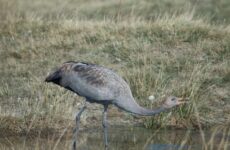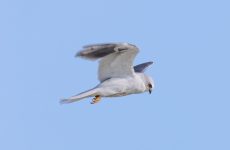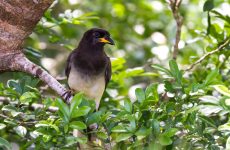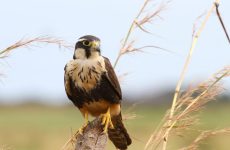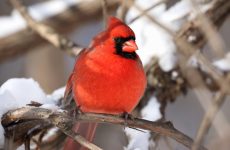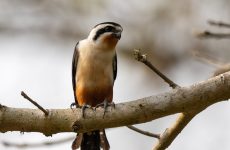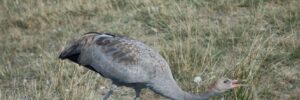
Winter is the best time to spot sparrows in Texas as many species migrate in to enjoy the warmer weather. However, there are a number of species that live here all year and some that you can spot just in summer or during their migration.
This guide will help you identify all 36 species of sparrows by sight and sound that can be spotted in Texas. Also, find out what time of year to spot them and some fun facts.
It is worth taking the time to get to know these energetic little songbirds that you will frequently spot and hear as they are fun to watch. Juncos and Towhees are also sparrows, so they are included in this guide.
Sparrows are often described as ‘little brown jobs’ by birders so it is obvious that it can be a challenge for even an experienced birder to recognize them.
Many sparrows have distinctive head markings and often migrate, so you can discount them at certain times of the year. These two pieces of information help with identification and are included in this guide.
Sparrows mainly eat seeds and insects, and they will often come to backyard feeders. Find out the other species of birds that regularly visit Texas and print a free ID chart.
This guide will help you identify the types of sparrows spotted in Texas that are classed as regularly occurring according to avibase and uses data collected from bird watchers on ebird to give real information about when these birds can be spotted.
When to Spot Sparrows in Texas
Knowing when you are most likely to spot sparrows can help reduce the guesswork with these similar-looking birds. This guide sorts these birds by when you are most likely to spot them.
Sparrows in Texas all year:
- House Sparrow
- Olive Sparrow
- Black-throated Sparrow
- Rufous-crowned Sparrow
- Canyon Towhee
- Grasshopper Sparrow
- Bachman’s Sparrow
Sparrows in Texas during migration:
- Clay-colored Sparrow
- Brewer’s Sparrow
Sparrows in Texas in summer:
- Lark Sparrow
- Cassin’s Sparrow
- Botteri’s Sparrow
Other Sparrows in Texas:
- Seaside Sparrows
- Black-chinned Sparrow
Sparrows in Texas in winter:
- Savannah Sparrow
- Chipping Sparrow
- Lincoln’s Sparrow
- White-crowned Sparrow
- White-throated Sparrow
- Dark-eyed Junco
- Song Sparrow
- Field Sparrow
- Spotted Towhee
- Vesper Sparrow
- Swamp Sparrow
- Harris’s Sparrow
- Fox Sparrow
- Lark Bunting
- Eastern Towhee
- LeConte’s Sparrow
- Green-tailed Towhee
- Nelson’s Sparrow
- Sagebrush Sparrow
- Henslow’s Sparrow
- American Tree Sparrow
- Baird’s Sparrow
Identifying Sparrow’s Songs
If you learn a few of the songs of sparrows by listening to the audio recordings in the guide, it will help, especially with some of the more distinctive sparrow songs. Such as White-throated Sparrows that sing long slow notes that change pitch and sound like a person whistling.
Field Sparrows can be easy to miss, except for their song that speeds up to a high trill at the end that is often likened to a bouncing ball coming to a stop.
Also, how about the strange buzz of the Grasshopper Sparrow or LeConte’s Sparrow? Have you heard them?
Sparrows in Texas All Year
House Sparrow
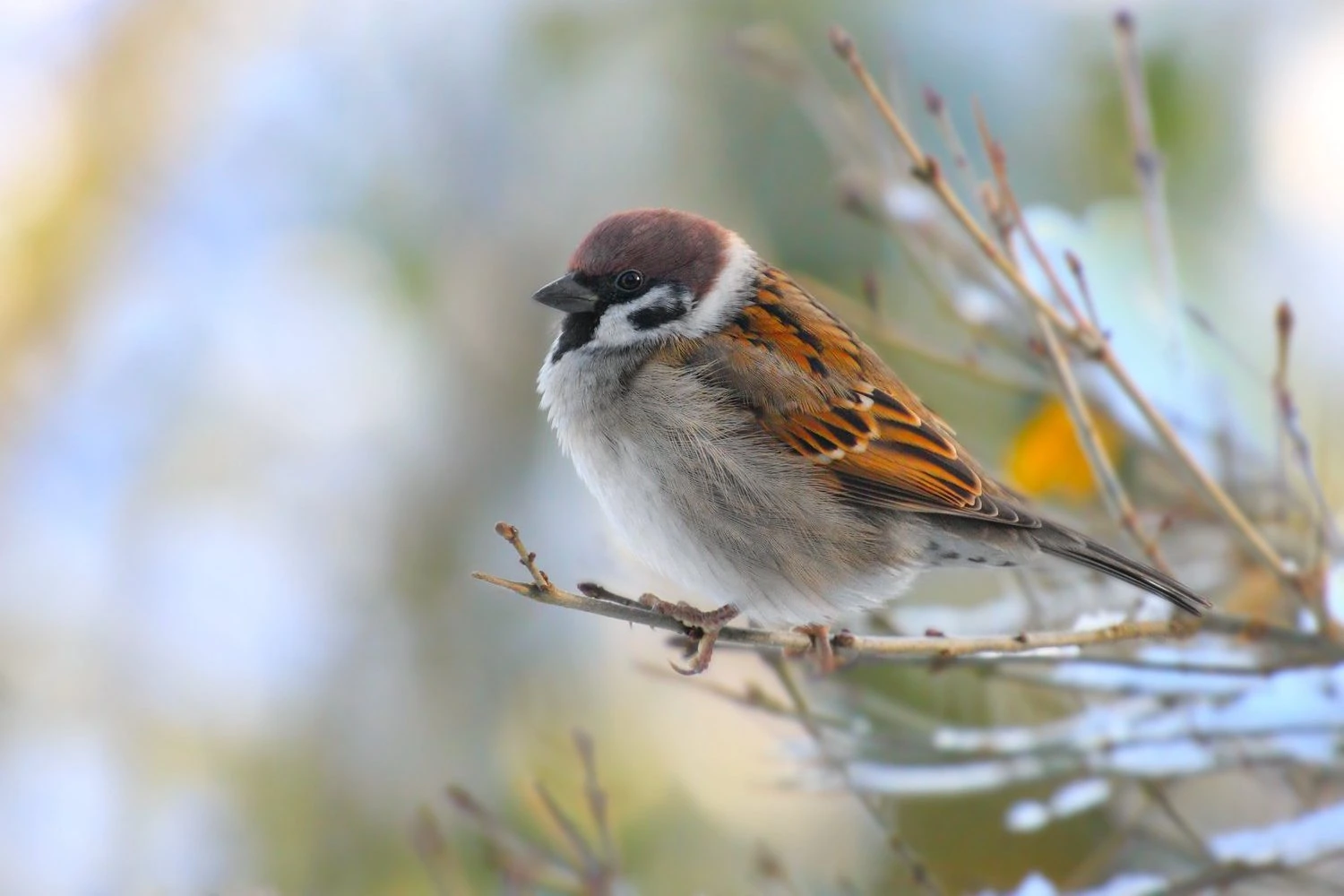
House Sparrows are an introduced species in Texas that can be spotted here all year. They do not migrate and occur in 29% of summer checklists and 21% of winter checklists submitted by the bird watchers for the state.
Olive Sparrow
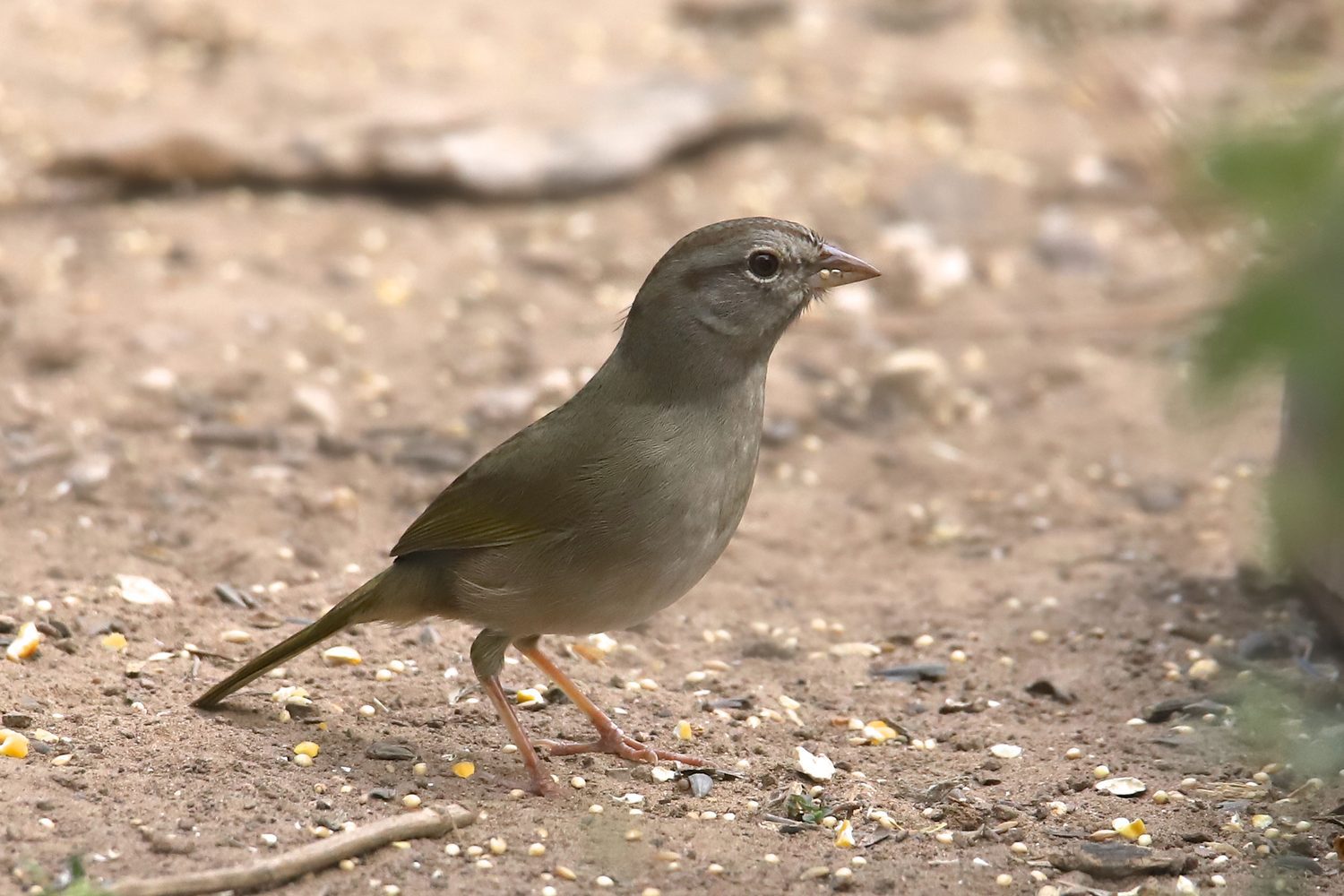
Olive Sparrows do not migrate and can be spotted in southern Texas all year.
Olive Sparrows are secretive birds with olive backs, hence their name. They have brown stripes on their gray heads but a plain, whitish chest and belly.
Olive Sparrows from the Pacific have darker, thicker stripes on their heads but the same coloring on the rest of their bodies. Males and females look the same. Juveniles are browner with streaks except on their belly and throat.
- Arremonops rufivirgatus
- Length: 6.55 in (17 cm)
- Weight: 0.8 oz (23 g)
- Wingspan: 9 in (23 cm)
Olive Sparrows do not migrate and can be found along the coasts of Mexico and in southeastern Texas all year.
You can find Olive Sparrows in densely vegetated areas, which is why their feather coloring is perfect for camouflage. They are also often found in weedy thickets and thorn scrubs.
Olive Sparrows forage low to the ground in pairs with their tails up in the air. They eat seeds and insects and would usually stay undercover, hopping from bush to bush.
Olive Sparrow Song:
Nests of Olive Sparrows are on the ground or placed in a bush or thorny shrubs. They are made with dried grass, bark, sticks, stems, and leaves and then lined with mammal fur. Females lay between two to five eggs that hatch after ten to twelve days.
Attract Olive Sparrows to your backyard by offering sunflower seeds on the ground. They would rather pick off the seeds that have fallen from the feeders rather than take them from the feeders themselves.
Fun Fact: If cowbirds lay their eggs in Olive Sparrow nests, then only cowbird chicks will be raised, and this is why they prefer dense vegetation for their nests.
Black-throated Sparrow
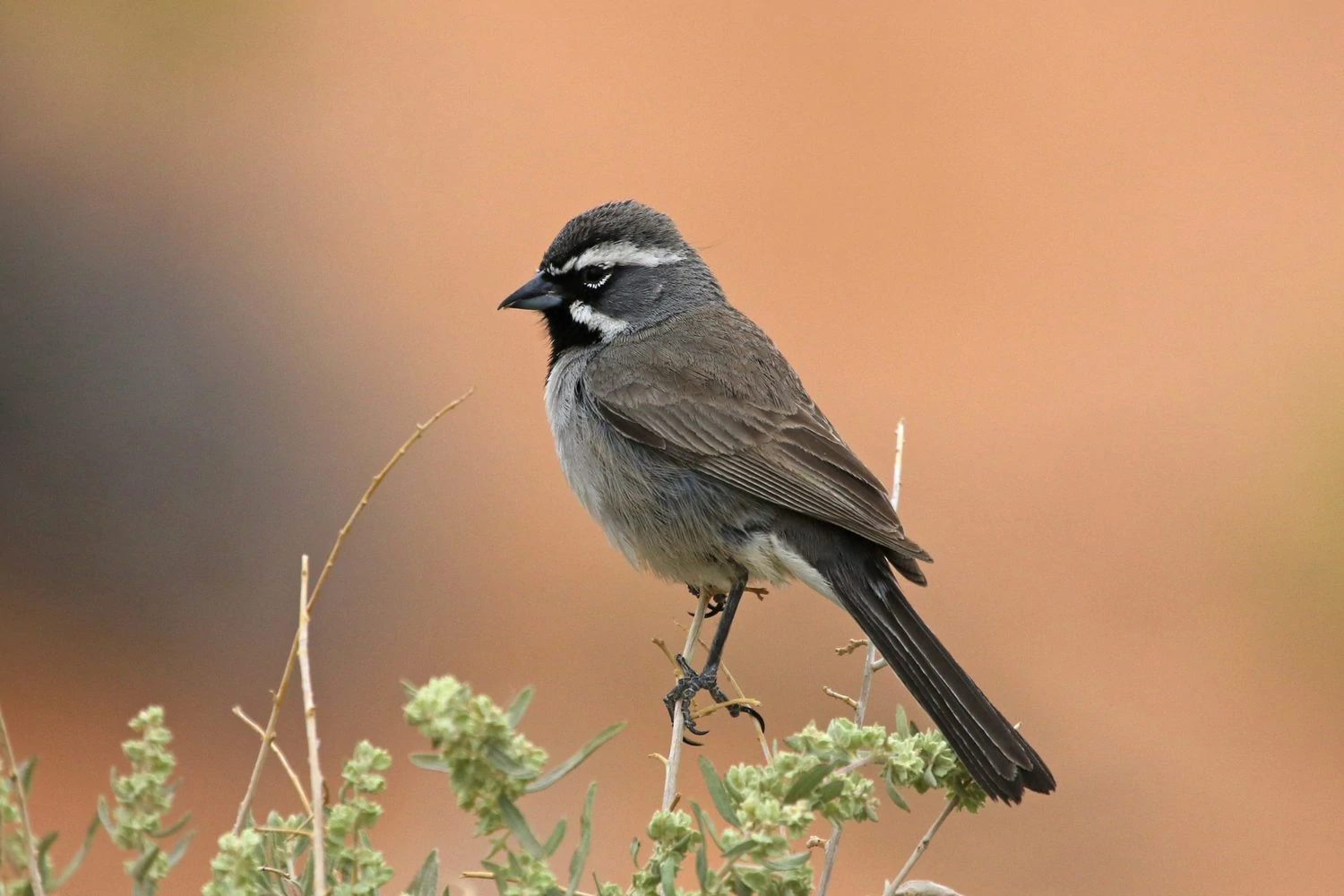
Black-throated Sparrow can be spotted in Texas all year, mostly in the southwest of the state.
Black-throated Sparrows are one of the most easily recognized sparrows with their distinctive black throat and two bright white stripes on each side of their gray heads. The rest of them is pale underneath and grayish-brown on the back.
- Amphispiza bilineata
- Length: 4.7-5.5 in (12-14 cm)
- Weight: 0.4-0.5 oz (11-15 g)
- Wingspan: 7.7 in (19.5 cm)
Black-throated Sparrows are sparrows of southwestern US states. Those that breed further north in their range migrate, but those in the south and Mexico remain all year.
You can find Black-throated Sparrows on the ground in open areas in canyons and desert scrub. They eat insects in summer and fallen seeds in winter.
Black-throated Sparrow sounds: The males’ song is a mix of some low notes, followed by a buzz and then a trill. The song is quite distinctive once you hear it a few times.
Nests of Black-throated Sparrows are low down in shrubs and made from desert plant material made into a cup shape and lined with soft grass and animal hair.
They lay up to five eggs, which take up to two weeks to hatch and a further ten days for the young to leave the nest.
Attract Black-throated Sparrows to your backyard with black oil sunflower seeds.
Fun fact: Black-throated Sparrows do not drink water during the hot desert summer and instead get all their moisture from the insects they eat.
Rufous-crowned Sparrow
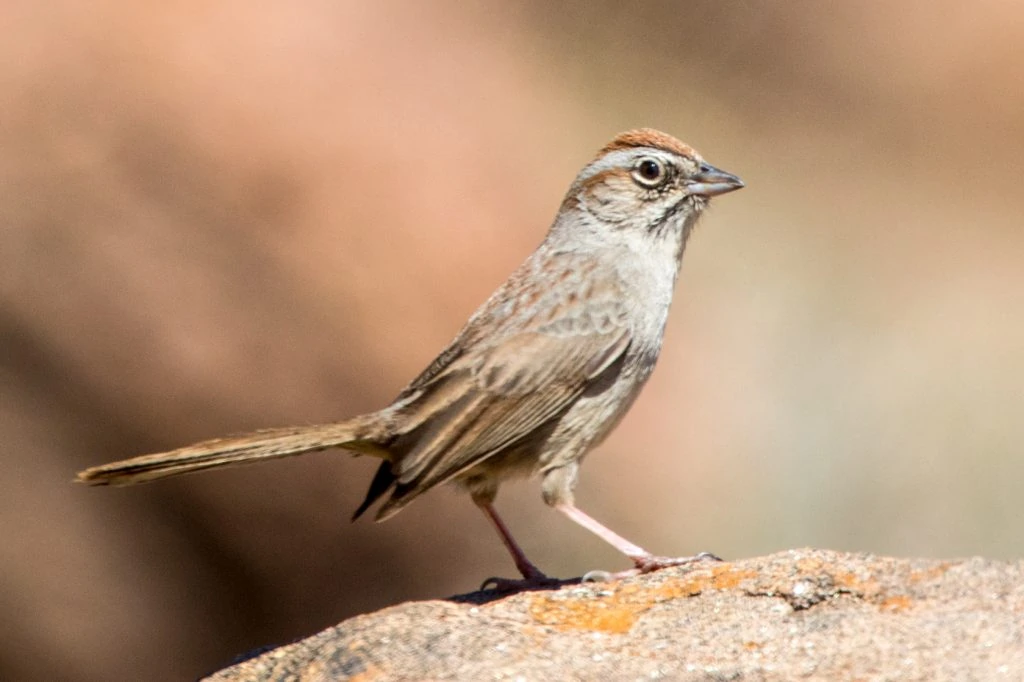
Rufous-crowned Sparrows do not migrate and are residents of Texas all year.
Rufous-crowned Sparrows are large sparrows that are gray underneath and streaked brown on the back. They have reddish-brown crowns and white and dark stripes on their faces.
- Aimophila ruficeps
- Length: 5.9-6.3 in (15-16 cm)
- Weight: 0.6-0.7 oz (16-21 g)
Rufous-crowned Sparrows are resident all year in southwestern US states.
You can find Rufous-crowned Sparrows on the ground in dry, rocky hillsides that have vegetation for them to hide. In spring, when males are singing, is the best time to spot them.
They eat insects in spring and summer and fallen seeds and other plant material in winter.
Rufous-crowned Sparrow sounds:
Nests of Rufous-crowned Sparrows are on the ground, hidden in vegetation, and built by females from dried grass and some twigs. They lay up to five eggs which take around two weeks to hatch and a further nine days for the young to leave the nest.
Fun Fact: Rufous-crowned Sparrows distract predators from nests by pretending to have a broken wing or by pretending to fall from a branch.
Canyon Towhee
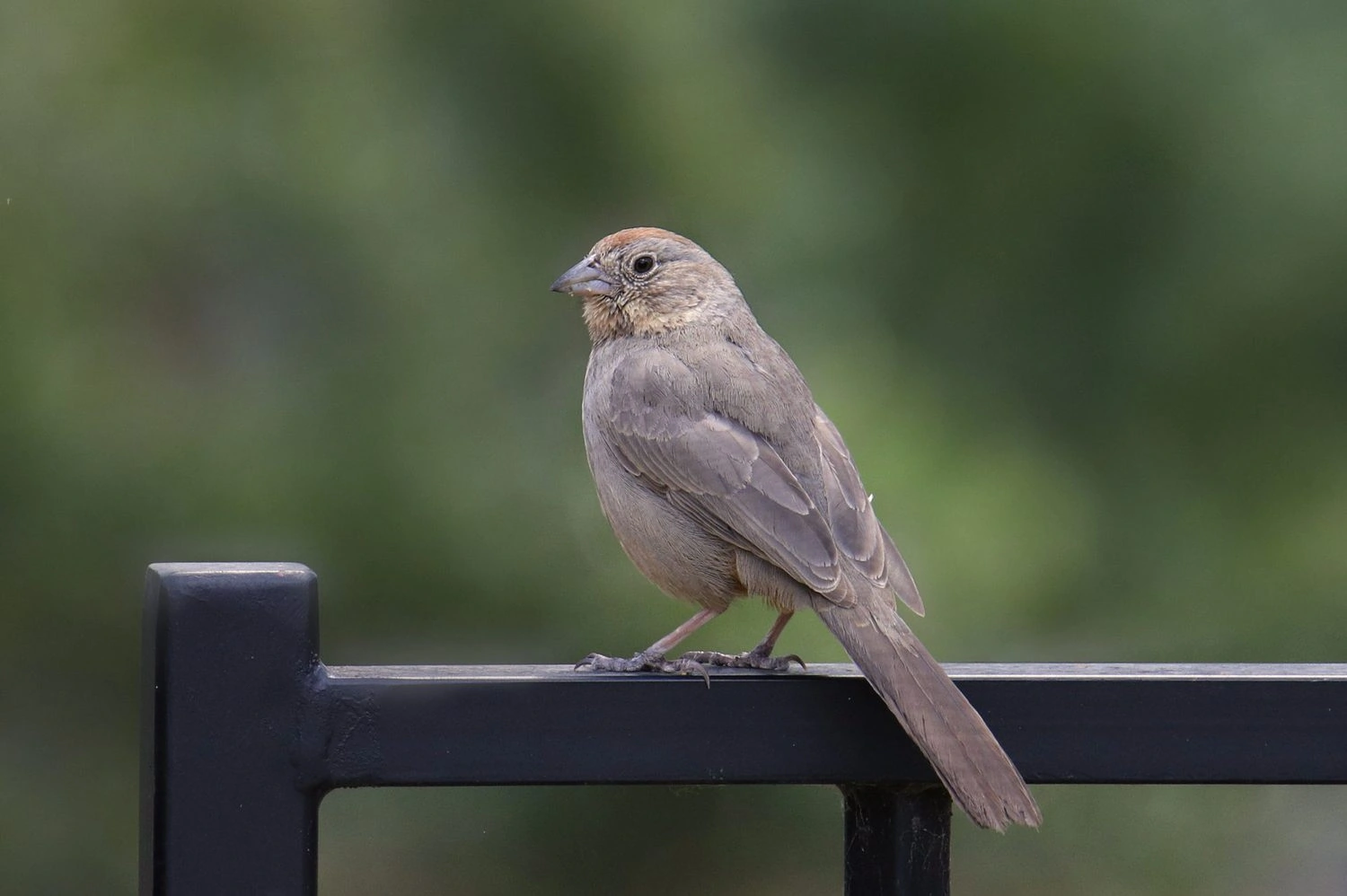
Canyon Towhees do not migrate and are residents all year in Texas.
Canyon Towhees are plain grayish-brown sparrows with long tails and plump bodies. Although they look similar to California Towhees, their range does not overlap.
- Melozone fusca
- Length: 8.3-9.8 in (21-25 cm)
- Weight: 1.3-1.9 oz (37-53 g)
- Wingspan: 11.5 in (29.21 cm)
Canyon Towhees are resident all year in southwestern US states and Mexico.
You can find Canyon Towhees on the ground in desert grassland foraging mainly for seeds and berries. However, they will also eat some grasshoppers and other insects.
Canyon Towhee sounds: Their song is fast, stuttering, and two-toned.
Nests of Canyon Towhees are placed near the trunk of trees and large shrubs, so they are well supported and hidden. The nest is made by the female from grass and plant material and is lined with soft grass and animal hair.
Attract Canyon Towhees to your backyard with black oil sunflower seeds, milo, millet, and oats scattered on the ground. However, they are shy birds that can be hard to attract.
Fun fact: Canyon Towhees will nest when the twice-yearly desert rains are due, which provides a sudden abundance of plants and insects.
Grasshopper Sparrow
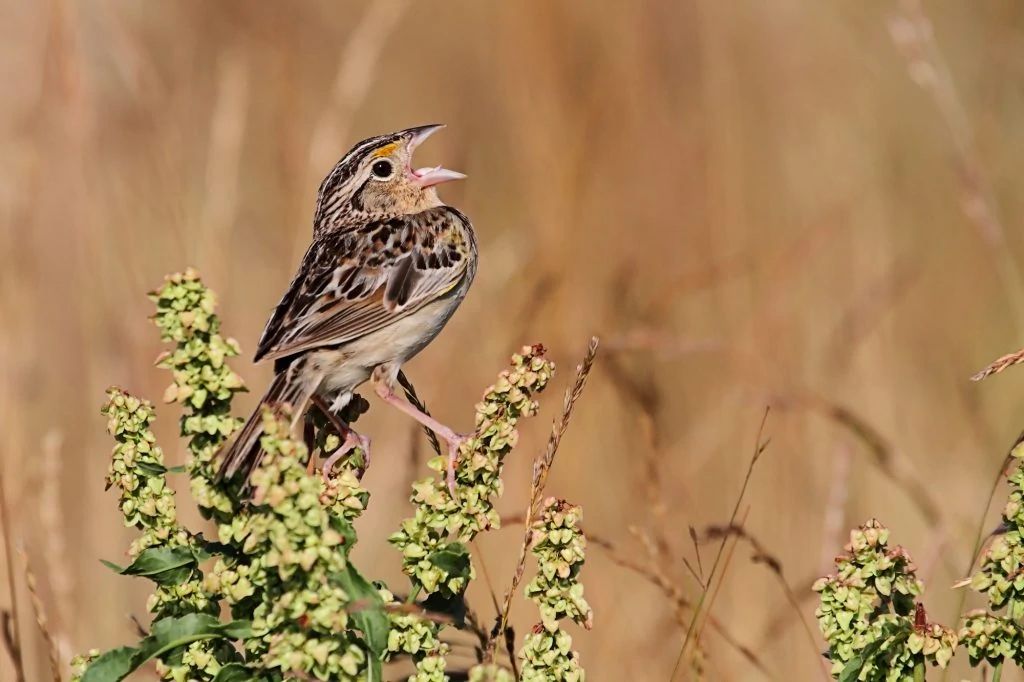
Grasshopper Sparrows breed in northern Texas and spend winter in the south, but some remain all year in central Texas.
Grasshopper Sparrows are tiny birds with light and dark brown streaking and a distinctive orange or yellow stripe above their eye. They have short tails, large bills, and pale bellies.
- Ammodramus savannarum
- Length: 4.3-4.5 in (10.8-11.5 cm)
- Weight: 0.5-0.7 oz (14-20 g)
- Wingspan: 7.9 in (20 cm)
Grasshopper Sparrows breed in central and eastern US states, California’s coast, and parts of northwestern US states. They spend winter in southeastern US states, Mexico, and the Caribbean.
You can find Grasshopper Sparrows on the ground in grassland and prairies or other open areas hunting for grasshoppers and other insects and spiders. In winter, they mostly eat fallen seeds.
Grasshopper Sparrow sounds: The buzzy insect-like song of the Grasshopper Sparrow is how they get their name.
Nests of Grasshopper Sparrows are on the ground in vegetation. They are made out of grasses and plant material, and they create a roof by weaving surrounding stalks and creating an entrance on the side.
They lay up to seven eggs four times during the breeding season. The eggs take up to two weeks to hatch and a further week or so for the young to leave the nest.
Fun Fact: Grasshopper Sparrows violently shake their grasshopper prey to remove the large legs so that they can feed the bodies to their young.
Bachman’s Sparrow
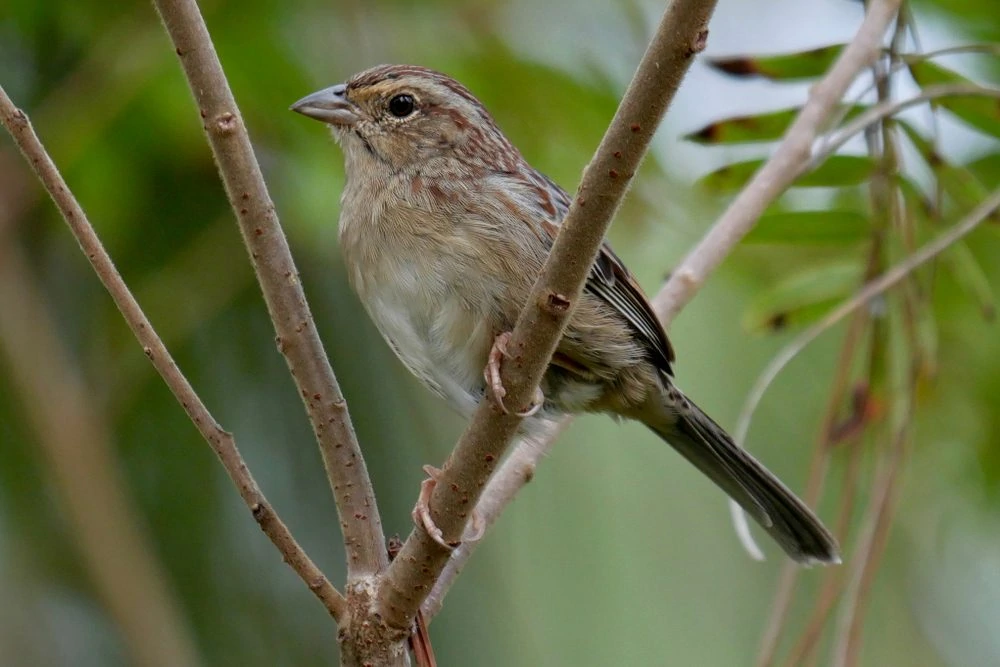
Bachman’s Sparrows are considered near-threatened species in Texas, and although they are rarely spotted here, they remain in the east of the state all year.
Bachman’s sparrows are medium-sized birds with brown heads and backs. They have a gray face with a dark reddish-brown line drawn from the back of their eye and light eyebrows. Their bellies and chests are white, but juveniles may have a few yellowish, streaky lines on their chests.
- Peucaea aestivalis
- Length: 12.4 -15.2 cm (4.9 – 6 in)
- Weight: 18 – 22 g (0.6 -0.8 oz)
- Wingspan: 18.4 cm (7.2 in)
Bachman’s Sparrows live in southeastern US states all year. However, those to the north of their range may migrate short distances south in winter.
You can find Bachman’s Sparrows in mature, open pine or oak forests. While this type of habitat is becoming scarce due to forest fires, they also live among grassy, weedy fields, bushy pastures, and scrubs.
Bachman’s Sparrows eat spiders and insects, like grasshoppers, crickets, beetles, caterpillars, wasps. They also eat seeds from blueberries and pines.
Bachman’s Sparrows song:
Nests of Bachman’s Sparrows are domed with a side entrance, made of woven grass and weeds, and lined with animal hair. They are often located on the ground, protected by tall shrubs and grass. Females lay up to five eggs that take about two weeks to hatch.
Fun Fact: To escape predators on the ground, Bachman’s Sparrows hide in empty gopher’s burrows.
Sparrows in Texas in Summer
Lark Sparrow
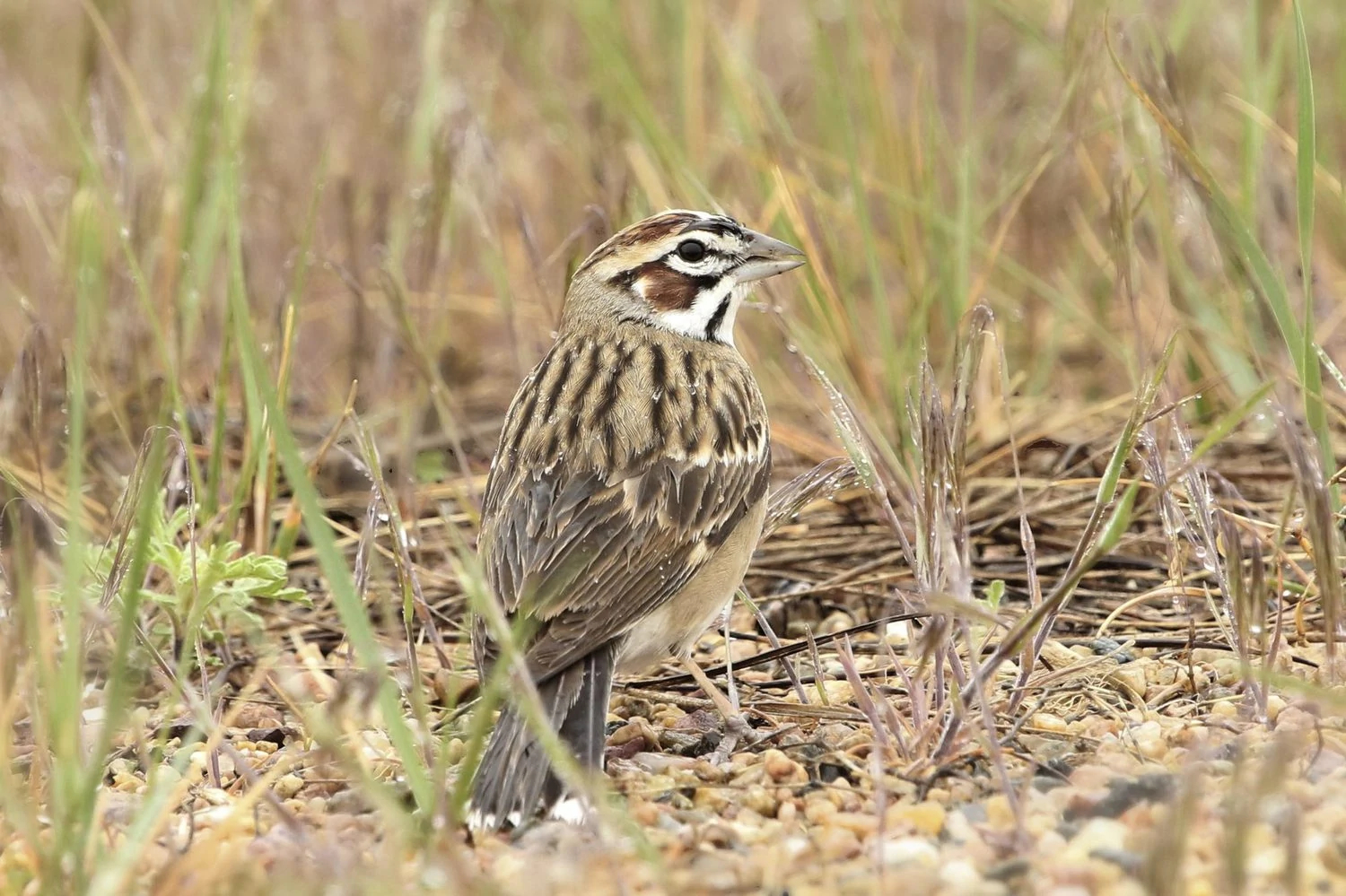
Lark Sparrows breed in Texas from April to September, but they also spend the winter in southeastern Texas. They appear in 10% of summer checklists.
The small Lark Sparrow has highly-distinctive features. It has a brown and white striped crown, brown-streaked back, white belly, and brown, white-edged tail.
- Chondestes grammacus
- Length: 5.9-6.7 in (15-17 cm)
- Weight: 0.8-1.2 oz (24-33 g)
- Wingspan: 11.0 in (28 cm)
Lark Sparrows breed in most US states, except towards the east. They also breed in some southern Canadian Provinces. Winter is spent in Mexico, but birds along the Pacific Coast, mainly in California and some southern states, remain all year.
You can find Lark Sparrows on the bare, open ground like grasslands, but they also favor trees and pastures with a few scattered shrubs.
Lark Sparrows will feast on many insects like grasshoppers, caterpillars, and beetles in summer and mostly seeds, grasses, and weeds during the winter.
Lark Sparrow sounds: The males’ song is a happy series of whistles, buzzes, and churr sounds.
Nests of Lark Sparrows are built by both males and females. The male will place twigs at the site, but females will do the actual construction. The nests can be on the ground, in low trees, and even in crevices in rocky cliffs.
The female creates an open cup made with grass, weeds, animal hair, and twigs. There are up to six eggs in a nest, and they take around twelve days to hatch and an additional ten days for the young to leave the nest.
Attract Lark Sparrows to your backyard with their favorite food, seeds.
Fun fact: Male Lark Sparrows take 5 minutes to dance during their courting ritual.
Cassin’s Sparrow
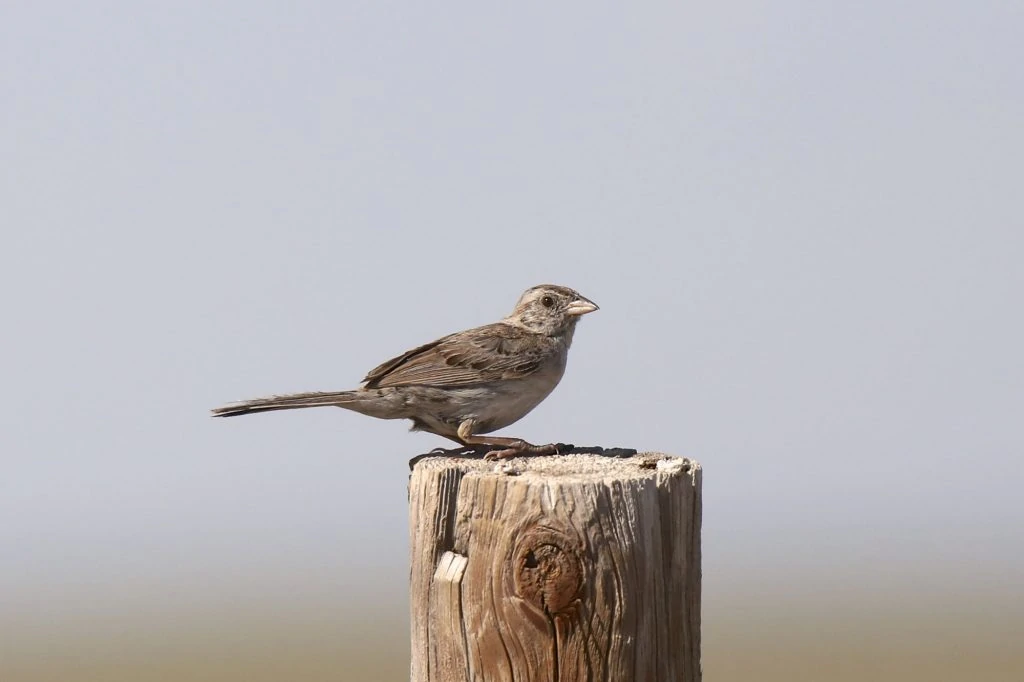
Although some can be seen here all year, Cassin’s Sparrows are more common in Texas during the breeding season, from March to September.
Cassin’s Sparrows are gray and brown with fine streaks on their head and throat. Their eyes have a white outline with a dark brown line extending from them. Their chest and bellies are lightly streaked with brown. Some birds have reddish tones.
- Peucaea cassinii
- Length: 15 cm (6 in)
- Weight: 20 g (0.7 oz)
- Wingspan: 23 cm (9 in)
Cassin’s Sparrows can be found in central US states and Mexico. Those further north in the range migrate short distances south for winter.
You can find Cassin’s Sparrows in semi-arid environments like deserts, grasslands with yucca, mesquite, oak, acacia trees, and shrubs. They prefer tall, dense grass for nesting and protection for their fledglings while they need proper perches on which to launch for flight and to display their melodious singing.
Cassin’s Sparrows feast on grasshoppers, caterpillars and beetles, and other small insects during summer. In winter, they mostly eat seeds from grasses and weeds.
Cassin’s Sparrow song:
Nests of Cassin’s Sparrows are often concealed amid tall grass. The nests are tunnel-like, made of grass, rootlets, flowers, and animal hair, and placed on the ground or at the bottom of cacti. There may be three to five eggs in a nest that take about two weeks to hatch. Both parents incubate their eggs.
Fun Fact: The male Cassin’s Sparrow may be plain and drab, but they make up for it in flair with their “skylarking”. They fly in the air and glide down while singing their song during the breeding season.
Botteri’s Sparrow
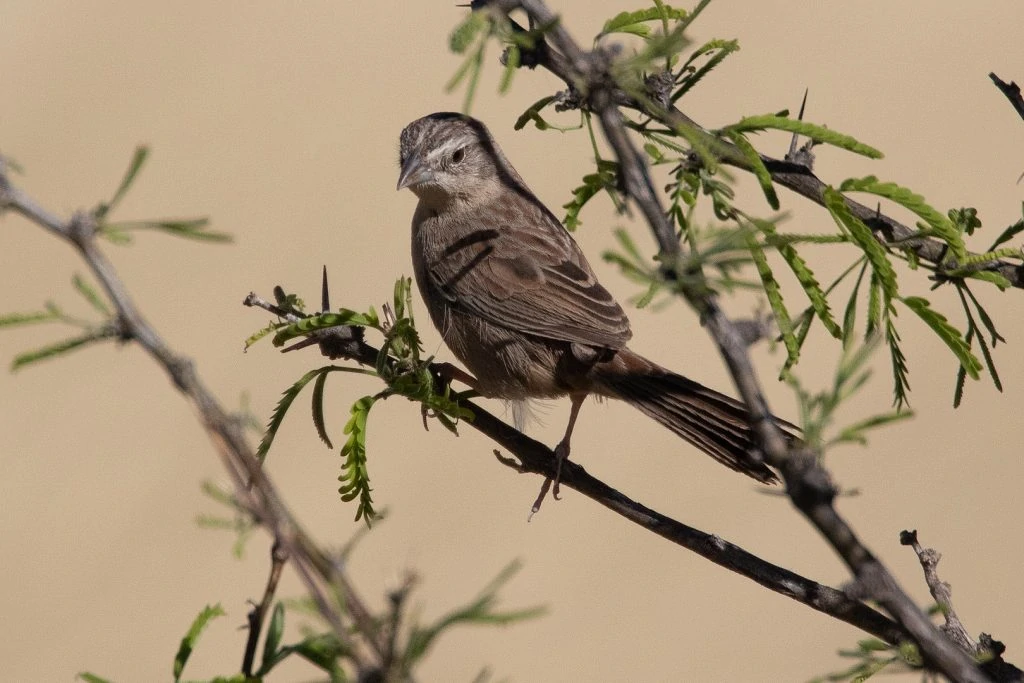
Botteri’s Sparrows are in southern Texas from April to mid-October, but they are rarely spotted.
Botteri’s Sparrows are medium-sized, pale birds that blend in with their desert surroundings. Their head is finely-streaked with red and tan lines. Their bodies are generally plain and light brown-colored. Their wings are rust-brown, and their bellies are grayish-tan. Males and females are similar. Juveniles are browner overall.
- Peucaea botterii
- Length: 15 cm (6 in)
- Weight: 20 g (0.7 oz)
- Wingspan: 23 cm (9 in)
Botteri’s Sparrows do not migrate and live in Mexico and just across the US border.
You can find Botteri’s Sparrows in semi-desert grasslands. Areas with native sacaton grass are a preferred habitat because they form dense clumps that provide necessary cover, especially for fledgling birds. There are also Botteri’s Sparrows that live in coastal prairies with scattered shrubs.
Botteri’s Sparrows’ favorite food is grasshoppers which they flush out of shrubs. They either chase them on foot or fly after them. When grasshoppers are nowhere to be found, they settle for beetles and their larvae, caterpillars and butterflies, seeds, and grasses.
Botteri’s Sparrow song:
Nests of Botteri’s Sparrows are found low to the ground, shrouded by dense clumps of tall grass. They are made of grass, rootlets, and lined with softer grass. There may be about five eggs per nest, and they take about a couple of weeks to hatch. Both parents share in the responsibility of their growing family.
Fun Fact: Botteri’s Sparrows were named after their discoverer, Matteo Botteri, an ornithologist.
Sparrows in Texas in Winter
Savannah Sparrow
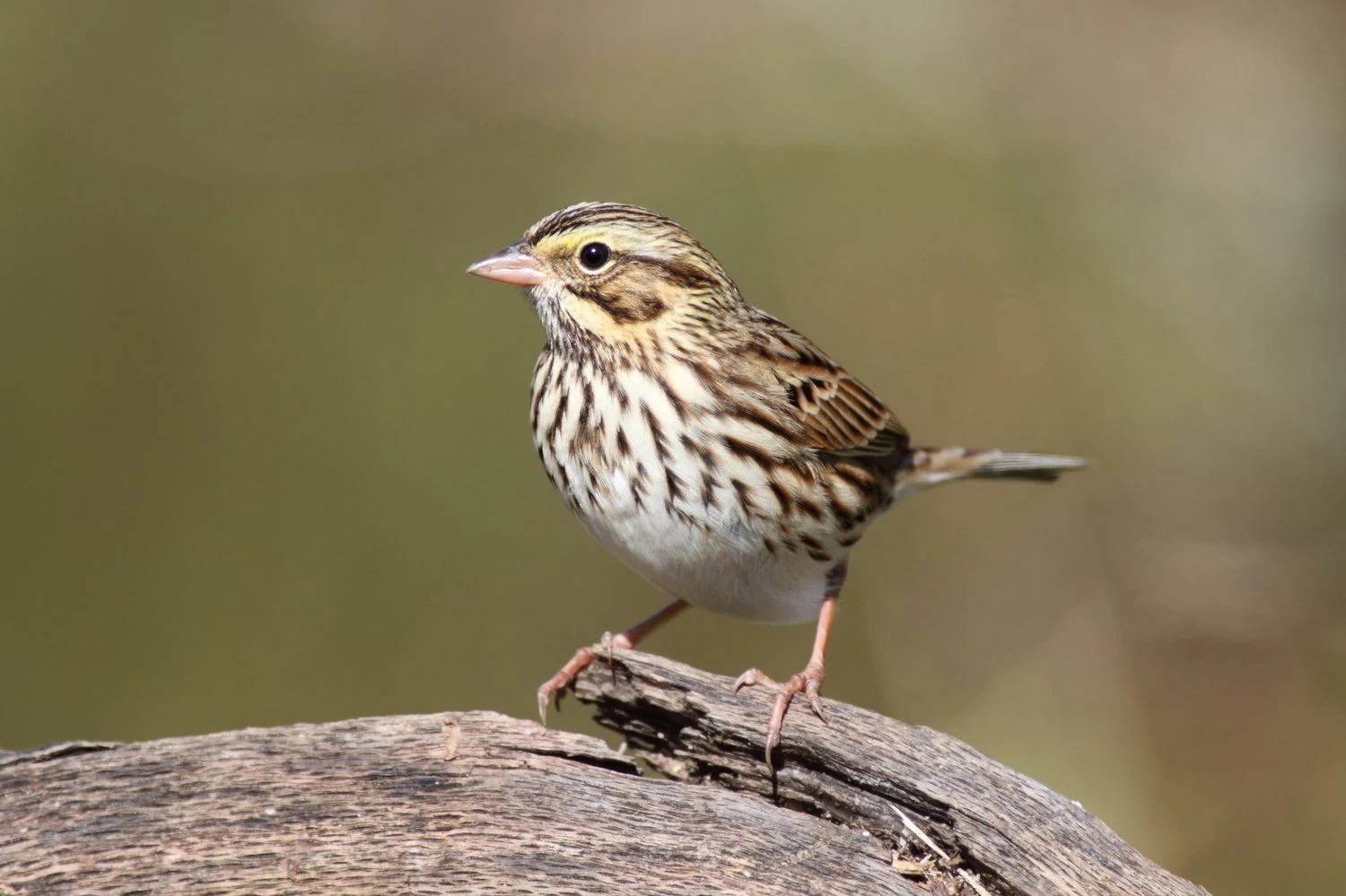
Savannah Sparrows are winter birds in Texas and occur in 14% of winter checklists. They are best spotted here from late September to May.
If you get close enough to a Savannah Sparrow, you will see this brown bird has a distinctive yellow patch by the eye. They also have short tails and a streaky brown coloring.
- Passerculus sandwichensis
- Length: 4.3-5.9 in (11-15 cm)
- Weight: 0.5-1.0 oz (15-28 g)
- Wingspan: 7.9-8.7 in (20-22 cm)
Savannah Sparrows breed in Canada and the US before migrating to southern US states and Mexico for winter.
You can find Savannah Sparrows on the ground in open areas, such as grassland, foraging for insects and spiders in the breeding season, and seeds in the winter.
Savannah Sparrow sounds: An almost rushed sounding song which is a few fast notes followed by a buzzing trill.
Nests of Savannah Sparrows are on or near the ground and made from grass. They lay up to six eggs, which take around two weeks to hatch and a further one or two weeks for the young to fledge.
These birds do not regularly visit feeders, but they may visit your yard if you keep brush piles, have long grass, and live near fields.
Fun fact: Although they are one of the most common songbirds in North America, they are considered a threatened species by the ICUN.
Chipping Sparrow
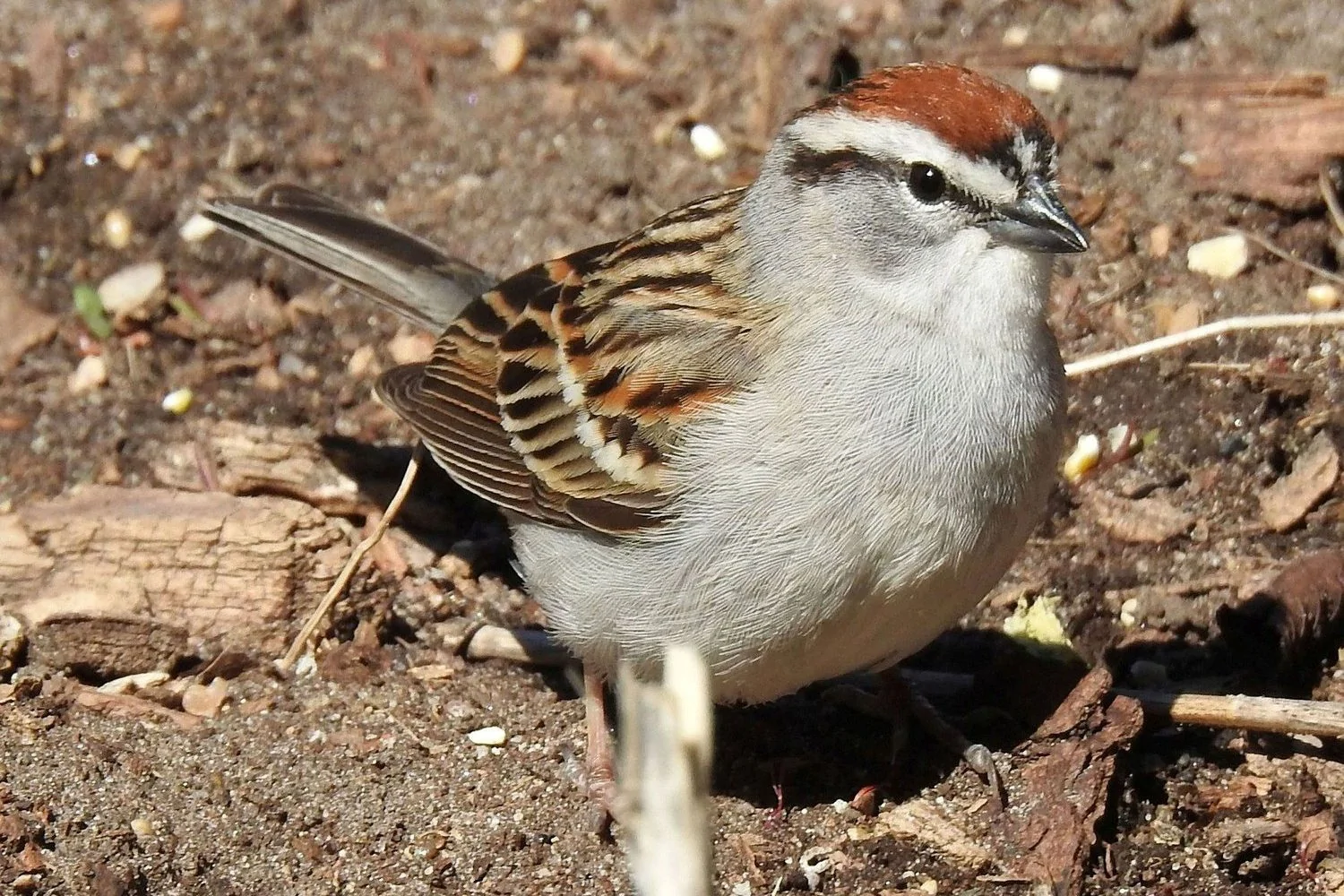
Chipping Sparrows are more commonly spotted in Texas during winter, but some remain here all year. They are recorded in 12% of winter checklists and 3% of summer checklists.
Chipping Sparrows are slender, long-tailed birds with a grayish belly and brown and black-streaked back, with a rusty crown and black eye line. In winter, the colors are more subdued.
- Spizella passerina
- Length: 4.7-5.9 in (12-15 cm)
- Weight: 0.4-0.6 oz (11-16 g)
- Wingspan: 8.3 in (21 cm)
Chipping Sparrows spend their summer breeding in the US and Canada before flying to Mexico and Florida for winter. Some remain all year in the southern US states.
You can find Chipping Sparrows in small flocks on the ground, often in woods and parks with trees.
Chipping Sparrow sounds: They get their name from the sharp ‘chip’ call they make. Their distinctive song is a stuttering trill.
Nests of Chipping Sparrows are off the ground, hidden in trees or shrubs, and are built by females. The nests are made from dried grass and small roots, but they are very basic and not very dense.
Chipping Sparrows lay up to seven eggs and up to three broods a year. The eggs take around two weeks to hatch, and the young fledge in under two weeks.
Attract Chipping Sparrows to your backyard with seeds or cracked corn on open feeders such as hoppers or platforms.
Fun fact: A group of Chipping Sparrows is known as a tournament.
Lincoln’s Sparrow
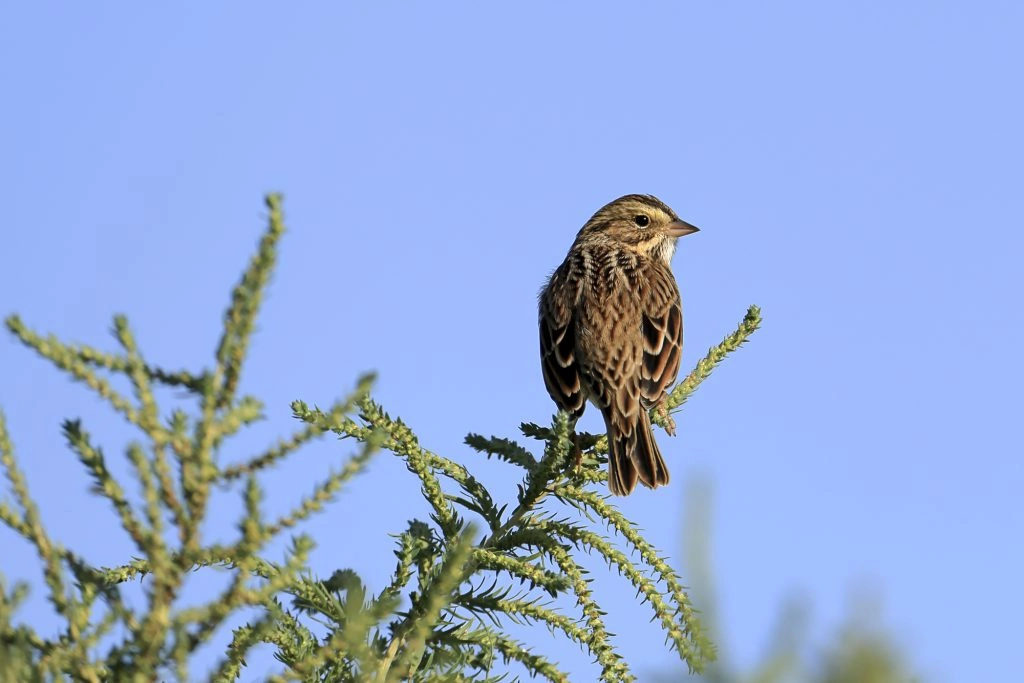
Lincoln’s Sparrows are spotted in Texas during winter, from September to May, and are recorded in 10% of winter checklists for the state.
Lincoln’s Sparrows are medium-sized sparrows, mainly gray in color and with streaks of brown across their wings and chest and white bellies. Their heads may look pointed when they raise their crown feathers. Its eyering is buffy and with a gray eyebrow area and dark eye line.
- Melospiza lincolnii
- Length: 5.1-5.9 in (13-15 cm)
- Weight: 0.6-0.7 oz (17-19 g)
- Wingspan: 7.5-8.7 in (19-22 cm)
Lincoln’s Sparrows breed in Canada and parts of western US states and migrate to southern US states, the Pacific Coast, and Mexico for winter. They can be seen during migration in the rest of the US.
You can find Lincoln’s Sparrow mostly in densely-covered shrubs and thickets, particularly near streams and wet or damp areas. They migrate to tropical but humid forests during the winter.
Lincoln’s Sparrows mostly eat weeds and grasses during the winter. During the breeding season, they will eat insects like spiders, ants, and caterpillars, but they still feed plants to their young.
Lincoln’s Sparrow sounds: Their song is a fast trill of notes and some buzzes that is one of the most tuneful of all the sparrows.
Nest of Lincoln’s Sparrows are built by females on the ground, protected and screened by thick shrubs. The nests are lined with moss or grass, and they lay around four eggs.
The eggs take up to two weeks to hatch, and the young leave the nest in under two weeks after hatching. Their flying skills improve fast, and by the 6th day, they can fly more than ten meters.
Fun fact: Lincoln’s Sparrows are very secretive birds and are not often seen but can be recognized by their sweet song.
White-crowned Sparrow
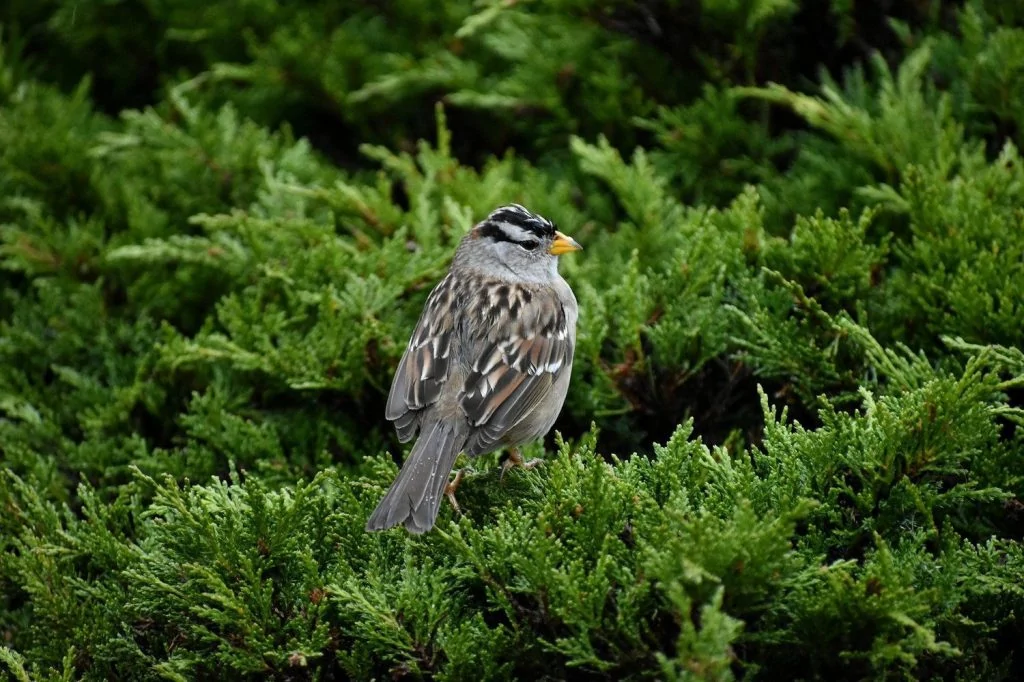
White-crowned Sparrows spend the winter in Texas and occur in 9% of checklists at this time. They are mainly spotted in the state from October until May.
White-crowned Sparrows are large grayish sparrows with long tails, small bills, and bold black and white stripes on their heads.
- Zonotrichia leucophrys
- Length: 5.9-6.3 in (15-16 cm)
- Weight: 0.9-1.0 oz (25-28 g)
- Wingspan: 8.3-9.4 in (21-24 cm)
White-crowned Sparrows breed in Alaska and arctic Canada before heading south to the lower 48 and Mexico for winter. However, some may remain along the Pacific Coast and the mountainous west all year.
You can find White-crowned Sparrows in weedy fields, along roadsides, forest edges, and in yards foraging for seeds of weeds and grasses or fruit such as elderberries and blackberries.
White-crowned Sparrow sounds: The males’ song is a clear whistle, followed by a series of chaotic whistles and finishing with a buzz. Calls are usually short and sharp. Females rarely call or sing.
Nests of White-crowned Sparrows are made from twigs, grass, moss, and pine needles, often low to the ground in shrubs or on the ground in the tundra. They lay up to seven eggs, which take up to two weeks to hatch and around nine days for the chicks to fledge.
Attract White-crowned Sparrows to your backyard with sunflower seeds, and they will also eat seeds dropped by other birds at the feeders.
Fun fact: Young White-crowned Sparrows take a further week or two to learn to fly after leaving the nest.
White-throated Sparrow
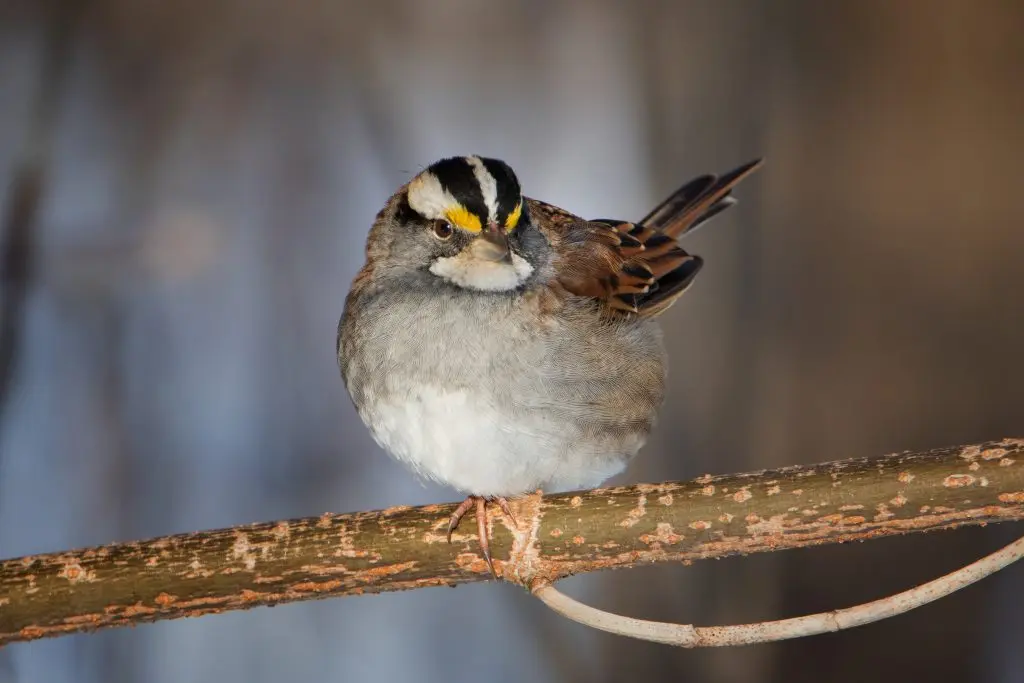
White-throated Sparrows are frequently spotted in Texas during winter and appear in 10% of winter checklists. They are mainly spotted here from October until April.
White-throated Sparrows have a distinctive black and white striped head, bright white throat, and yellow between the eye and bill. Their backs are brown, and underneath is gray. There are two color differences with birds having either tan-striped or white-striped heads.
- Zonotrichia albicollis
- Length: 6.3-7.1 in (16-18 cm)
- Weight: 0.8-1.1 oz (22-32 g)
- Wingspan: 7.9-9.1 in (20-23 cm)
White-throated Sparrows are migratory birds, breeding mainly in Canada before heading south in winter to eastern and southern US states and the Pacific Coast.
You can find White-throated Sparrows on the ground in forests and woods and along the edges of wooded areas, often in large flocks.
White-throated Sparrows eat mainly seeds of grasses and weeds as well as fruits such as grape, sumac, mountain ash, blueberry, blackberry, and dogwood. They will also eat many insects from the forest floor, especially in summer.
White-throated Sparrow sounds: Their distinctive whistle is a few long, slow notes that change pitch. They can sound like a person whistling.
Nests of White-throated Sparrows are built by females, usually on the ground or low to the ground, in dense vegetation. They are made from moss and twigs, lined with softer material such as grass and animal hair.
They lay up to six eggs, which take around two weeks to hatch and a further week to two weeks for the young to fledge.
Attract White-throated Sparrows to your backyard feeders with millet and black oil sunflower seeds on platform feeders.
Fun fact: White-throated Sparrows always breed with the opposite color morph, either tan-striped or white-striped heads.
Dark-eyed Junco
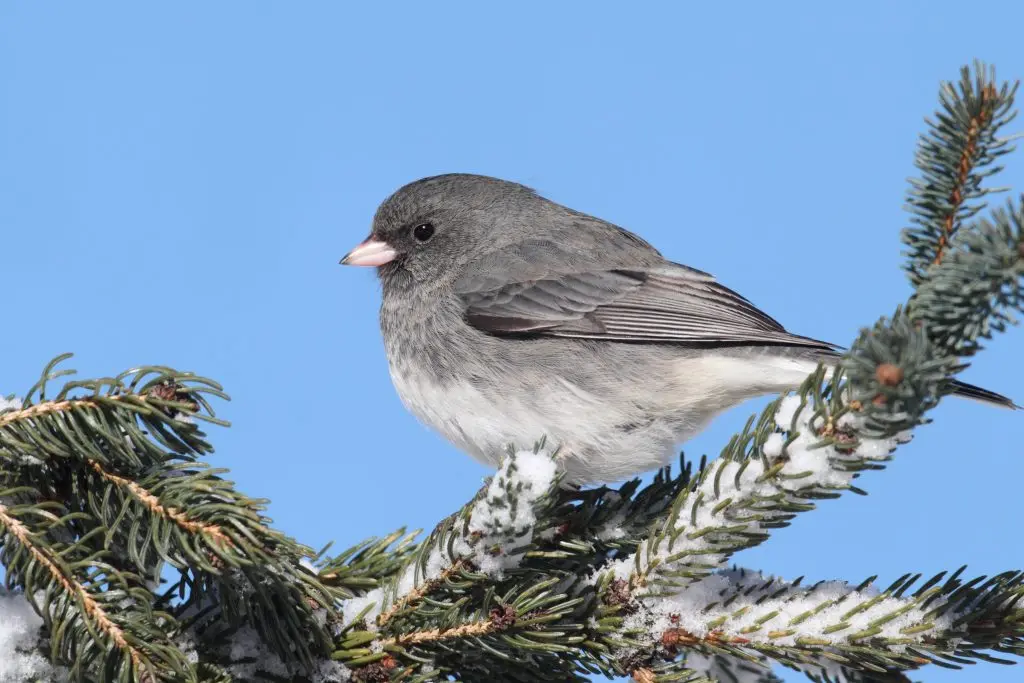
Dark-eyed Juncos are mainly spotted in Texas during winter from October to April and occur in 10% of winter checklists.
Dark-eyed Juncos are sparrows that are different a color depending on the state. They are generally slate-colored in the east and black, white, and brown in the west.
- Junco hyemalis
- Length: 5.5-6.3 in (14-16 cm)
- Weight: 0.6-1.1 oz (18-30 g)
- Wingspan: 7.1-9.8 in (18-25 cm)
Dark-eyed Juncos remain resident all year in the northeastern and western US states and the Appalachian Mountains. Those that breed in Canada and Alaska migrate south in winter to the United States.
You can find Dark-eyed Junco in open and partially wooded areas, often on the ground, and they are common across the continent. They mainly feed on seeds but will also eat some insects.
Dark-eyed Junco sounds: A simple song of a series of fast, high-pitched even notes.
Nests of Dark-eyed Juncos are usually on the ground, hidden in vegetation, woven from plant material, and lined with grass and hair. They lay up to six eggs, which take around two weeks to hatch and two weeks to fledge.
Attract Dark-eyed Juncos to backyard feeders with a variety of seeds such as black oil sunflower seeds, nyjer, cracked corn, millet, and peanuts. Platform feeders or seeds scattered on the ground are best.
Fun fact: Dark-eyed Juncos are known as snowbirds as they arrive in the United States in winter.
Song Sparrow
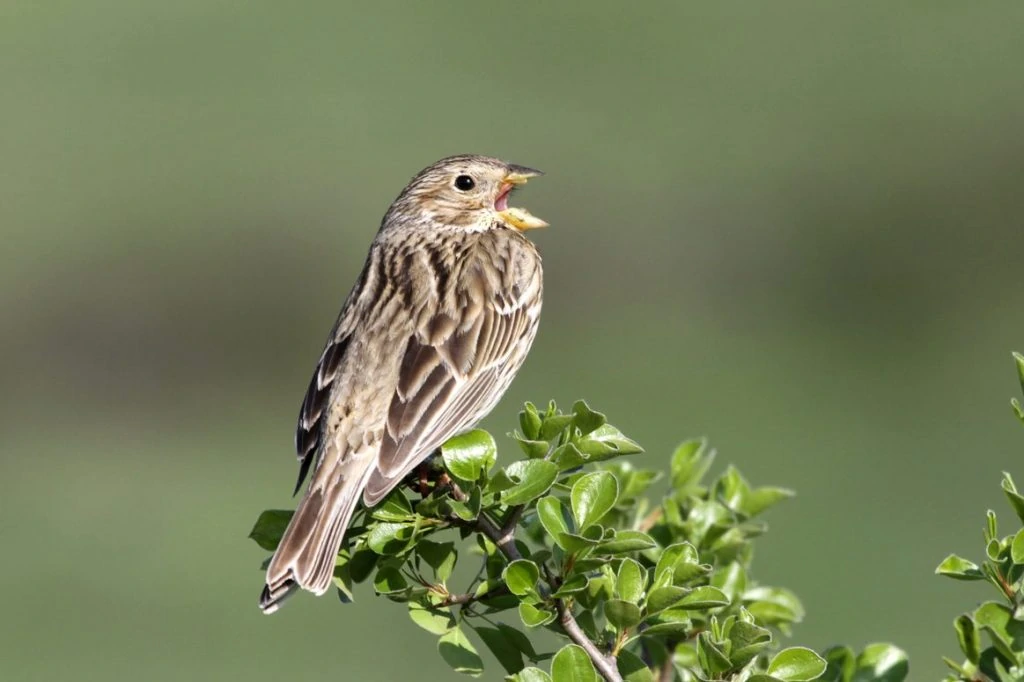
Song Sparrows are winter birds in Texas, and they start arriving in September and some stay until May, but October until April are the best months to spot them. They are recorded in 8% of winter checklists.
Song sparrows are not as remarkable looking as other backyard birds, but these predominantly brown-streaked birds use their almost constant song to attract mates in spring and summer.
- Melospiza melodia
- Length: 4.7-6.7 in (12-17 cm)
- Weight: 0.4-1.9 oz (12-53 g)
- Wingspan: 7.1-9.4 in (18-24 cm)
Song Sparrow live all year in the northern US States. Those that breed in Canada migrate to southern US states for winter.
You can find Song Sparrows in open, shrubby, and wet areas, often perched on a low shrub singing. They are often found at backyard feeders.
Song Sparrows eat a wide variety of insects and plants, including beetles, caterpillars, midges, spiders, and earthworms. They will also eat buckwheat, sunflower seeds, raspberries, wild cherries, blackberries, wheat, and rice.
Song Sparrow sounds: They make a series of unconnected buzzing, trills, and notes rather than a melodious song. They also make sharp alarm calls and chatter calls when in groups.
Nests of Song Sparrows are made from grass and other plant material woven together and lined with soft grass and hair. They lay up to six eggs, which take around two weeks to hatch and just under two weeks for the young to leave the nest.
Attract Song Sparrows to your backyard by putting black oil sunflower seeds, cracked corn, and nyjer on platform feeders.
Fun fact: A study has found that Song Sparrows mix their playlist of songs, so they do not repeat and potentially bore prospective females!
Field Sparrow
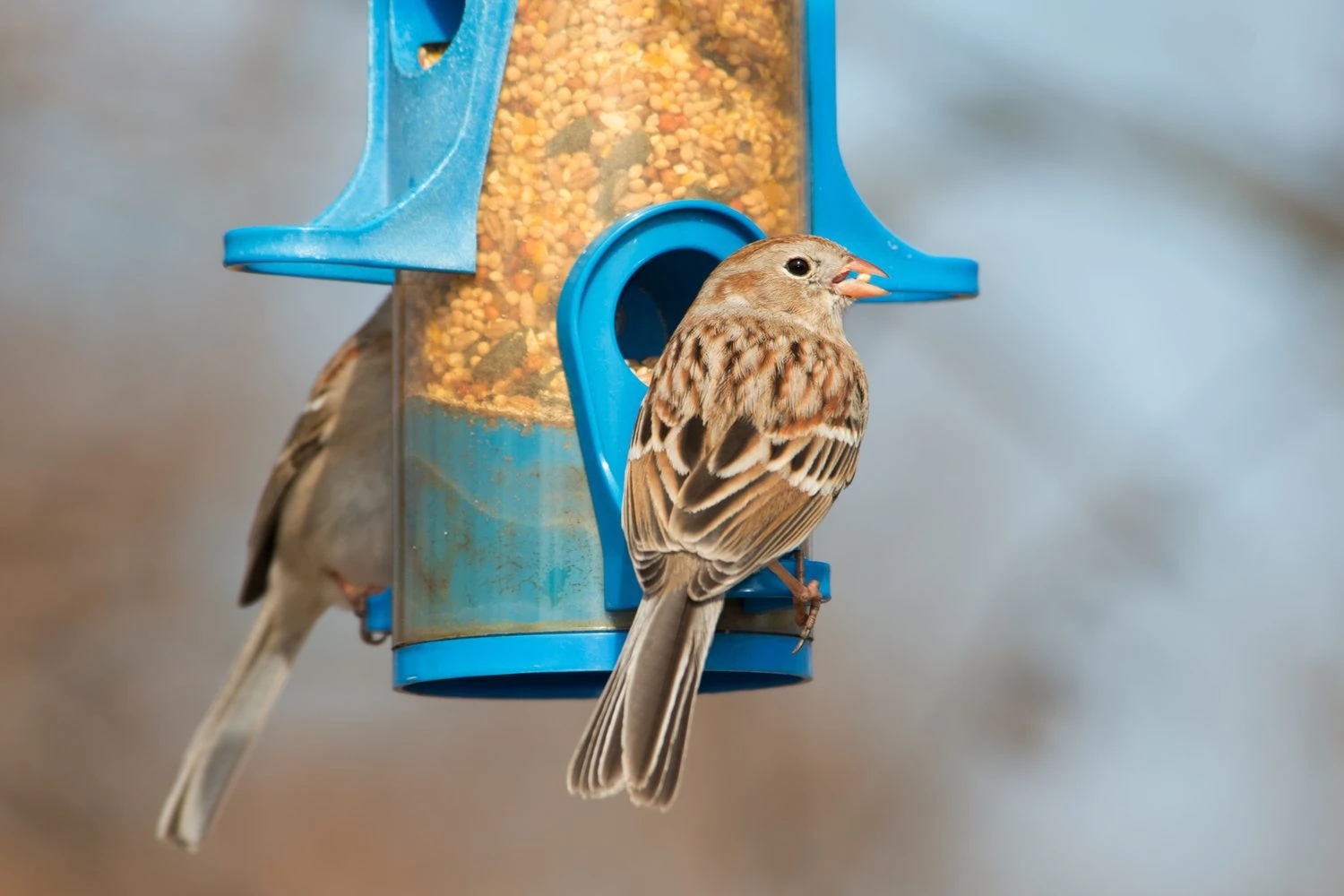
Although some can be seen here all year, Field Sparrows are more commonly spotted in Texas during winter, from November to March. They appear in 5% of winter checklists.
Field Sparrows are small, slender brown-backed birds streaked with black. Their undersides are gray, as are their heads, and they have a reddish crown and pink bill.
- Spizella pusilla
- Length: 4.7-5.9 in (12-15 cm)
- Weight: 0.4-0.5 oz (11-15 g)
- Wingspan: 7.9 in (20 cm)
Field Sparrows remain all year in eastern US states, but those that breed in the Midwest head south for winter.
You can find Field Sparrows in the breeding season as the males will sing from a perch in the early mornings, so they are easier to spot. Otherwise, they quietly feed on weeds and seeds and can be easily missed as they prefer abandoned fields and are shy.
Field Sparrow sounds: A few slow notes that then rapidly speed up into a trill.
Nests of Field Sparrows are built on the ground for the first brood and then higher and higher as the breeding season goes on. Their nests are made from grass, and they lay up to five eggs which take around two weeks to hatch. After that, the young only take around a week to fledge.
Attract Field Sparrows to your backyard with cracked corn, hulled sunflower seeds, and millet.
Fun fact: The Field Sparrows’ song is often thought to sound like a bouncing ball coming to a stop.
Spotted Towhee
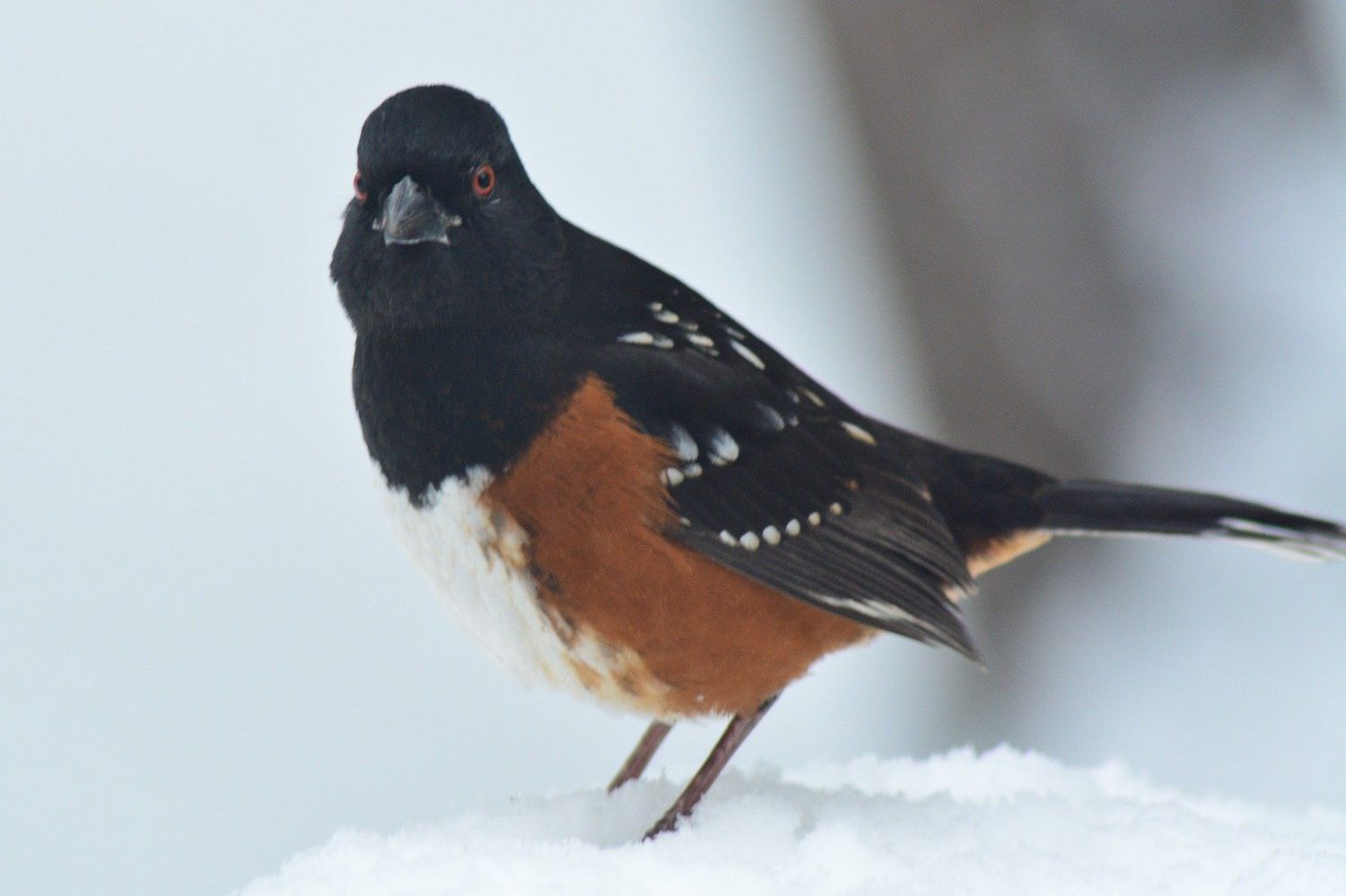
Spotted Towhees spend the winter in Texas and are recorded in 4% of checklists at this time. However, some stay in the state all year.
Spotted Towhees are large sparrows that are black on the head, throat, and back in the males and brown in the females. Both males and females have reddish-brown sides and white bellies, with white spots on their wings and back and long tails.
- Pipilo maculatus
- Length: 6.7-8.3 in (17-21 cm)
- Weight: 1.2-1.7 oz (33-49 g)
- Wingspan: 11.0 in (28 cm)
Spotted Towhees live in western US states, but those inland in the north migrate south to Texas after breeding.
Spotted Towhees can be found on the ground in dense tangles of shrubs scratching around for insects, including beetles, crickets, grasshoppers, caterpillars, wasps, and bees. They also eat acorns, berries, and seeds.
Spotted Towhee sounds: Songs are short notes followed by fast trills.
Nests of Spotted Towhees are usually on or near the ground and made from leaves, stems, and bark lined with softer material. They lay up to six eggs, which take around two weeks to hatch and a further ten days for the young to fledge.
Attract Spotted Towhees to your yard if you leave overgrown borders, and they will visit platform feeders or ground feeders for Black Oil Sunflower seeds, Hulled Sunflower seeds, Cracked Corn, Millet, and Milo.
Fun fact: Spotted Towhee males spend most of their mornings singing when trying to attract a mate.
Vesper Sparrow
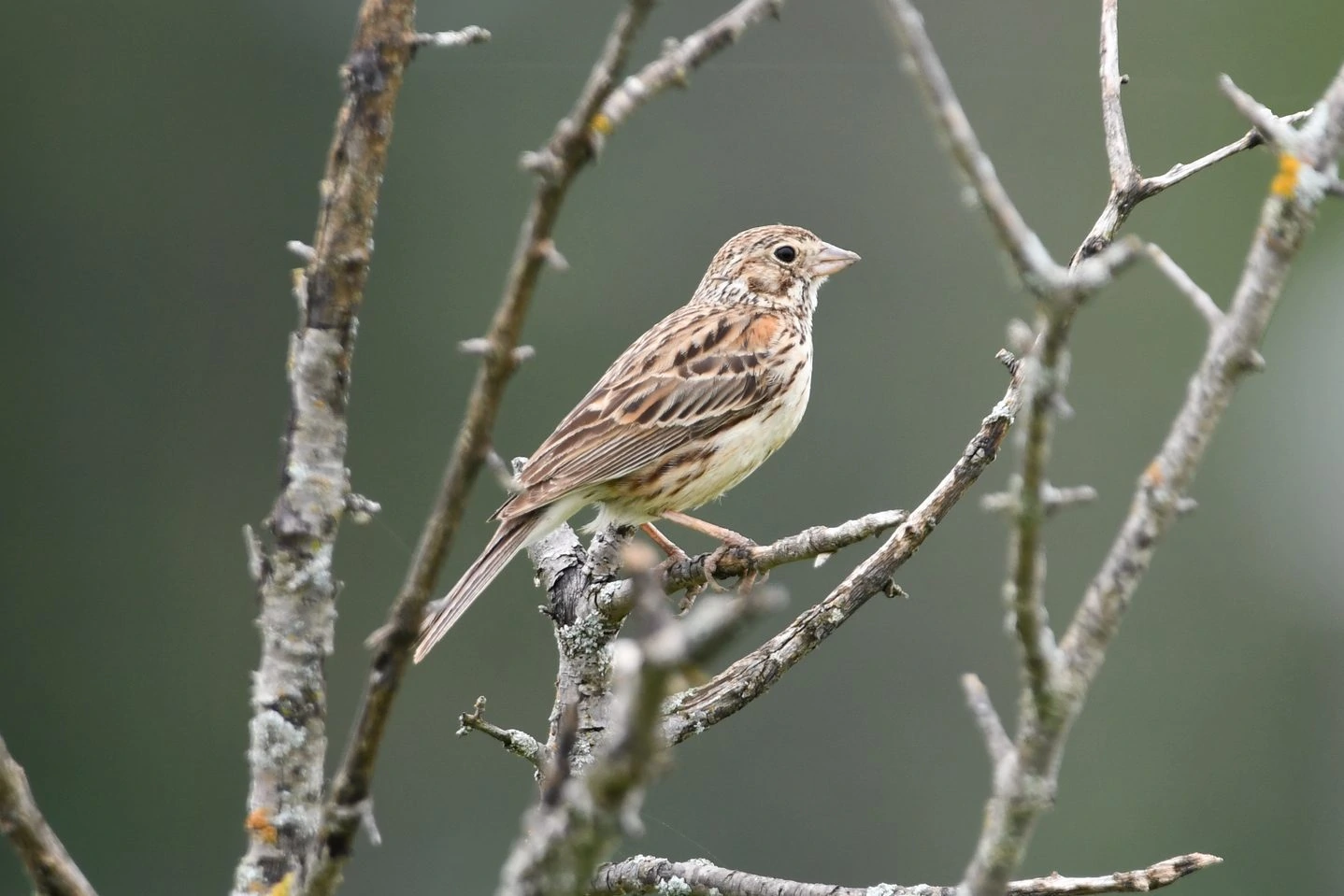
Vesper Sparrows appear in 4% of winter checklists in Texas, and they are commonly spotted from mid-September until May.
Vesper Sparrows are quite large sparrows that are mostly brown on the back, with white streaks and white bellies.
- Pooecetes gramineus
- Length: 5.1-6.3 in (13-16 cm)
- Weight: 0.7-1.0 oz (20-28 g)
- Wingspan: 9.4 in (24 cm)
Vesper Sparrows spend the summer breeding in the northern half of the US, southern Canada, and down into southwestern US states. Then, they migrate to southern US states and Mexico for winter.
You can find Vesper Sparrows on the ground in open grasslands and weedy fields and meadows. They eat seeds of grasses and weeds and some insects and spiders.
Vesper Sparrow sounds: Males start with a few low whistles followed by a series of rising and falling trills.
Nests of Vesper Sparrows are on the ground and made from grass, bark, and moss. They lay up to six eggs which take up to two weeks to hatch and a further one or two weeks for the young to leave the nest.
Fun fact: Male Vesper Sparrows run after females with their wings raised, leaping into the air and singing to attract their attention.
Swamp Sparrow
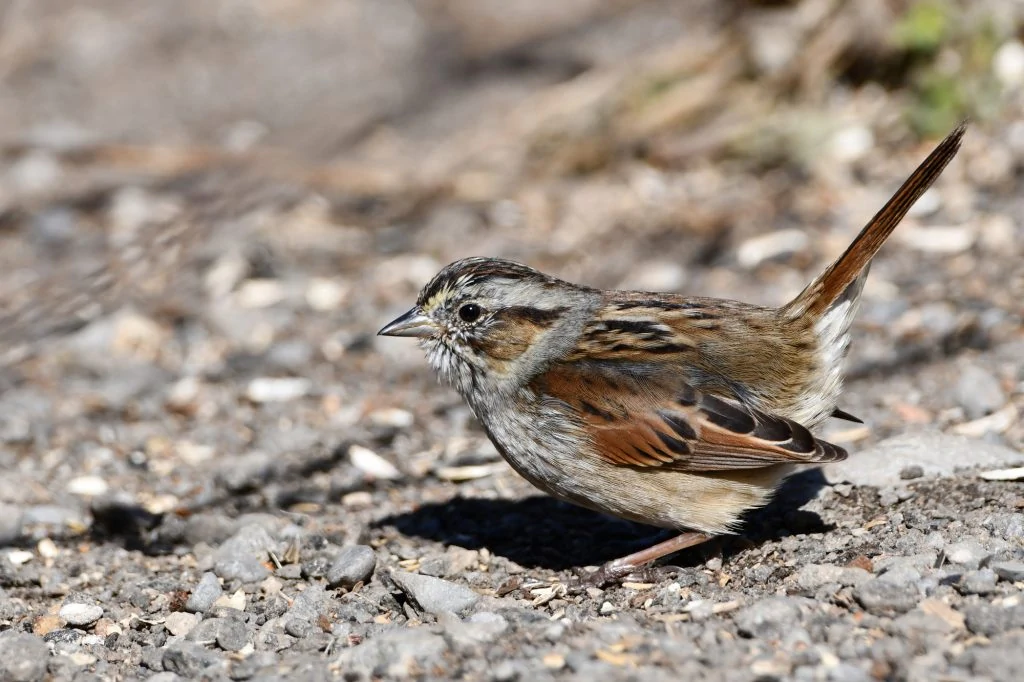
Swamp Sparrows spend the winter in Texas and can be seen from September until May. They appear in 4% of winter checklists in Texas.
Swamp Sparrows are dark brown on the back with rusty crowns and wings. They have gray breasts and white throats. Their heads are gray, and they have brown faces with a dark eye line and yellow end to the beak.
- Melospiza georgiana
- Length: 4.7-5.9 in (12-15 cm)
- Weight: 0.5-0.8 oz (15-23 g)
- Wingspan: 7.1-7.5 in (18-19 cm)
Swamp Sparrows are more located in the east. They breed in Canada and northeastern and North Central US states before migrating to eastern and southern US states and Mexico.
As the name would suggest, Swamp Sparrows are found in wetlands, swamps, bogs, and coastal marshes. They feed on seeds and fruit, especially in winter, and insects in spring.
Swamp Sparrow sounds: Their song is a rapid trill of the same note.
Nests of Swamp Sparrows are usually hidden in vegetation on or close to the ground and made from twigs, leaves, and cattails. The nest is lined with grass and other plant material.
They lay up to six eggs, which take two weeks to hatch, and the young take a further one or two weeks to fledge.
Swamp Sparrows do not visit backyards except in migration to yards with lots of vegetation and water.
Fun fact: Swamp Sparrows sing before dawn when it is still dark.
Harris’s Sparrow
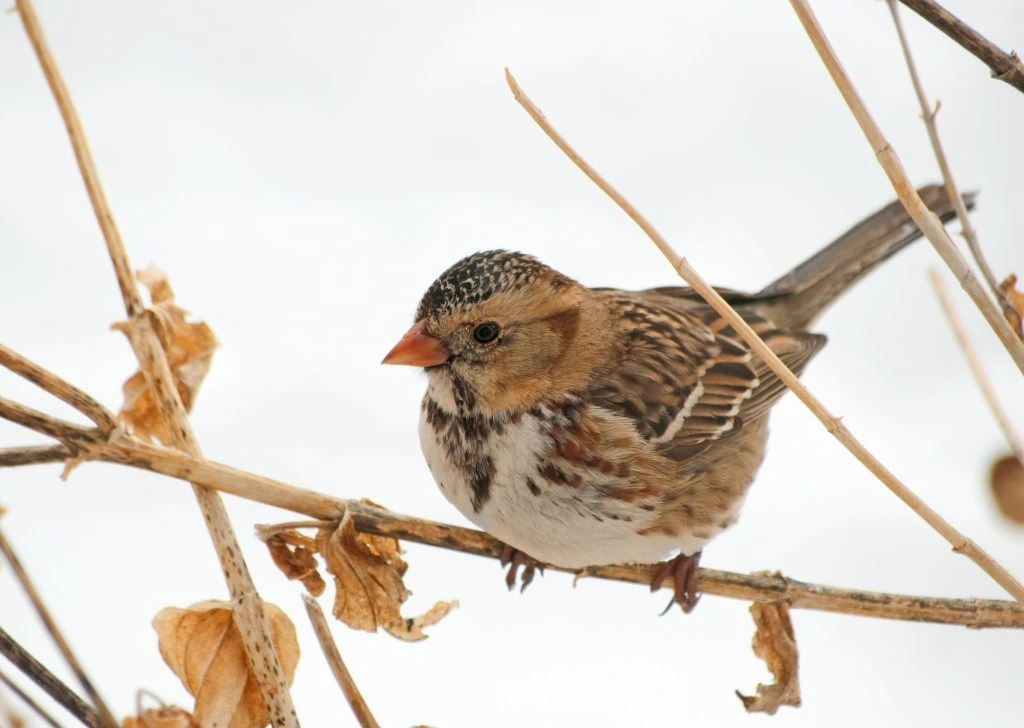
Harris’s Sparrows are considered near-threatened species, but they can be spotted in Texas during winter, mostly from November to April.
Harris’s Sparrows are distinctive, with a black face and bib darker in adults than juveniles. They also have brown-streaked bodies, with pale bellies and pink bills. Breeding adults have gray heads, but non-breeding adults have brown heads.
- Zonotrichia querula
- Length: 6.7-7.9 in (17-20 cm)
- Weight: 0.9-1.7 oz (26-49 g)
- Wingspan: 10.6 in (27 cm)
Harris’s Sparrows breed in the northern tundra of central Canada and migrate to south-central Great Plains for winter. They can be seen during migration across central US states and Canadian provinces.
You can find Harris’s Sparrows out in the open during their migration or in winter in fields or other open areas. They eat seeds, fruit, insects, and especially crowberries in spring when nesting, and there is less food around.
Harris’s Sparrow Call/Song:
Nests of Harris’s Sparrows are on the ground and made from twigs and moss and lined with soft grass. They lay up to five eggs which take around two weeks to hatch and a further nine days or so for the young to leave the nest.
Attract Harris’s Sparrows to your backyard in winter with black oil sunflower seeds, millet, and cracked corn.
Fun fact: Harris’s Sparrows are the only songbird that breeds in Canada and nowhere else.
Fox Sparrow
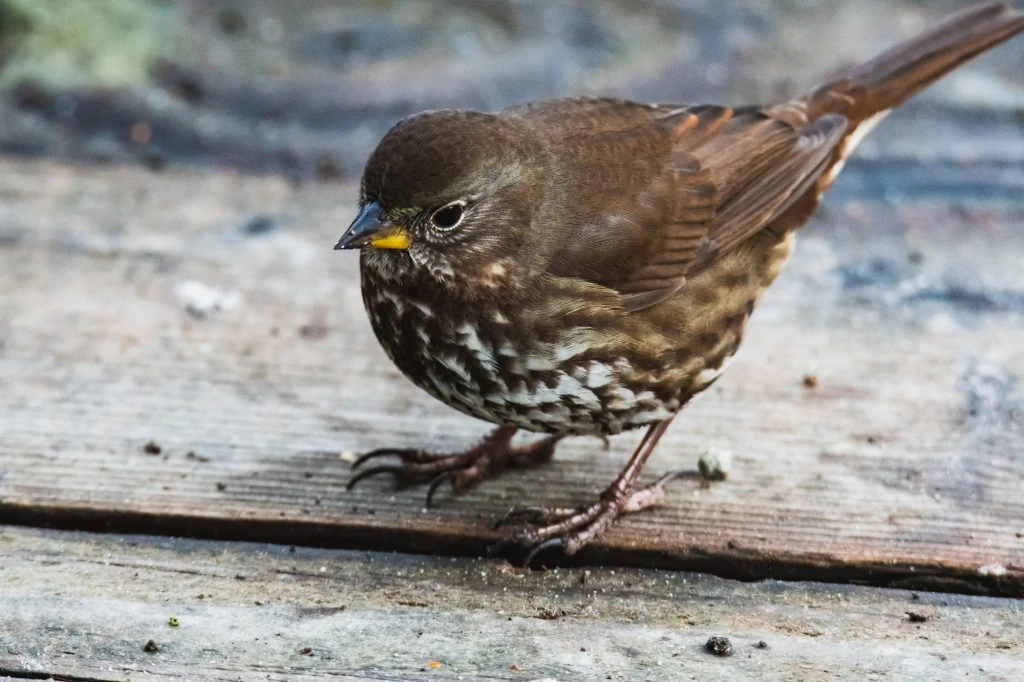
Fox Sparrows spend the winter in Texas and can be spotted from mid-September until mid-May. They are recorded in 2% of winter checklists for the state.
Although some species are more gray or dark brown, the Fox Sparrow is aptly named after its fox-red coloring. Its reddish streaks are particularly obvious in its chest area. It is a chunky bird compared to other sparrows.
There are four different color and appearance variations in Fox Sparrows. Red Fox Sparrows are found in eastern areas, and darker ‘sooty’ Fox Sparrows are found along the Pacific Coast. Thick-billed Fox Sparrows are found in California, and Slate-colored Fox Sparrows are found in western US states.
- Passerella iliaca
- Length: 5.9-7.5 in (15-19 cm)
- Weight: 0.9-1.6 oz (26-44 g)
- Wingspan: 10.5-11.4 in (26.7-29 cm)
Fox Sparrows migrate and breed in the north and west of Canada, Alaska, and down as far as California in the western US.
They spend the winter in southeastern US states and along the Pacific coast. Some remain all year on Canada’s Pacific coast, and they can be seen during migration in central and northeastern US states.
You can find Fox Sparrows in wooded areas, undergrowth, and brush. In the winter, they migrate to similar areas, even in well-vegetated suburbs and parks. You may observe them kicking up leaf litter in the air in search of food on the ground.
Insects and seeds are a common diet of Fox Sparrows. At times, they may also eat berries and grasses and crustaceans and marine animals if they’re near the beach.
Fox Sparrow sounds: Males sing a pleasant series of whistles and buzzy notes.
Nests of Fox Sparrow are hidden under dense, low shrubs. They may also build them in low trees but not more than eight feet above the ground. The nest is covered with grass, weeds, and moss but lined with dry grass. For those above ground, twigs are used to toughen up the nest’s walls.
They lay two to five eggs, which take about two weeks to hatch. The young may leave the nest within eleven days of hatching.
Attract Fox Sparrows to your backyard with small seeds and berries and low native shrubs.
Fun fact: The female Fox Sparrow can build a nest in a flash. They can start a nest at sunrise and finish it by dusk!
Lark Bunting
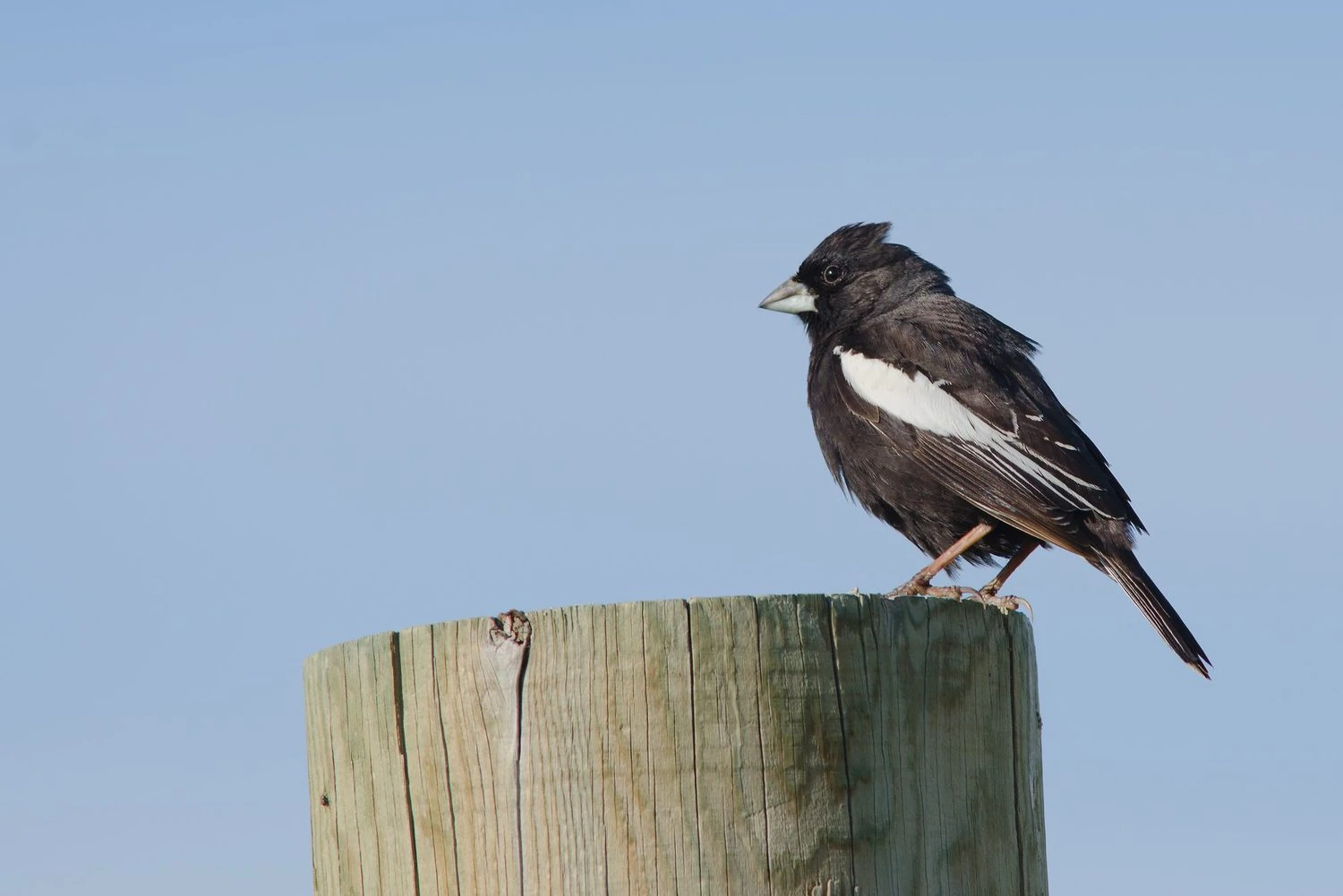
Lark Buntings spend winter in Texas and are mainly seen from August to May.
Male Lark Buntings are one of the easiest of the sparrow family to recognize. Males are black with a white wing patch. However, females and non-breeding males are brown-streaked in color, but they also have white in their wings.
- Calamospiza melanocorys
- Length: 5.5-7.1 in (14-18 cm)
- Weight: 1.3-1.5 oz (35.3-41.3 g)
- Wingspan: 9.8-11.0 in (25-28 cm)
Lark Buntings breed in central states and southern Canada and migrate to the southern Great Plains and northern Mexico for winter. However, some birds remain all year in southern US states.
You can find Lark Bunting on the ground in open grasslands and prairie with sagebrush. They eat seeds, insects, and some fruit.
Lark Bunting Call/Song:
The nests of Lark Bunting are built by both males and females and are made from grass and leaves lined with soft grass and animal hair. They lay up to five eggs that take around eleven days to hatch and a further week for the young to leave the nest.
Fun fact: Male Lark Buntings sing while flying back down from height in the breeding season.
Eastern Towhee
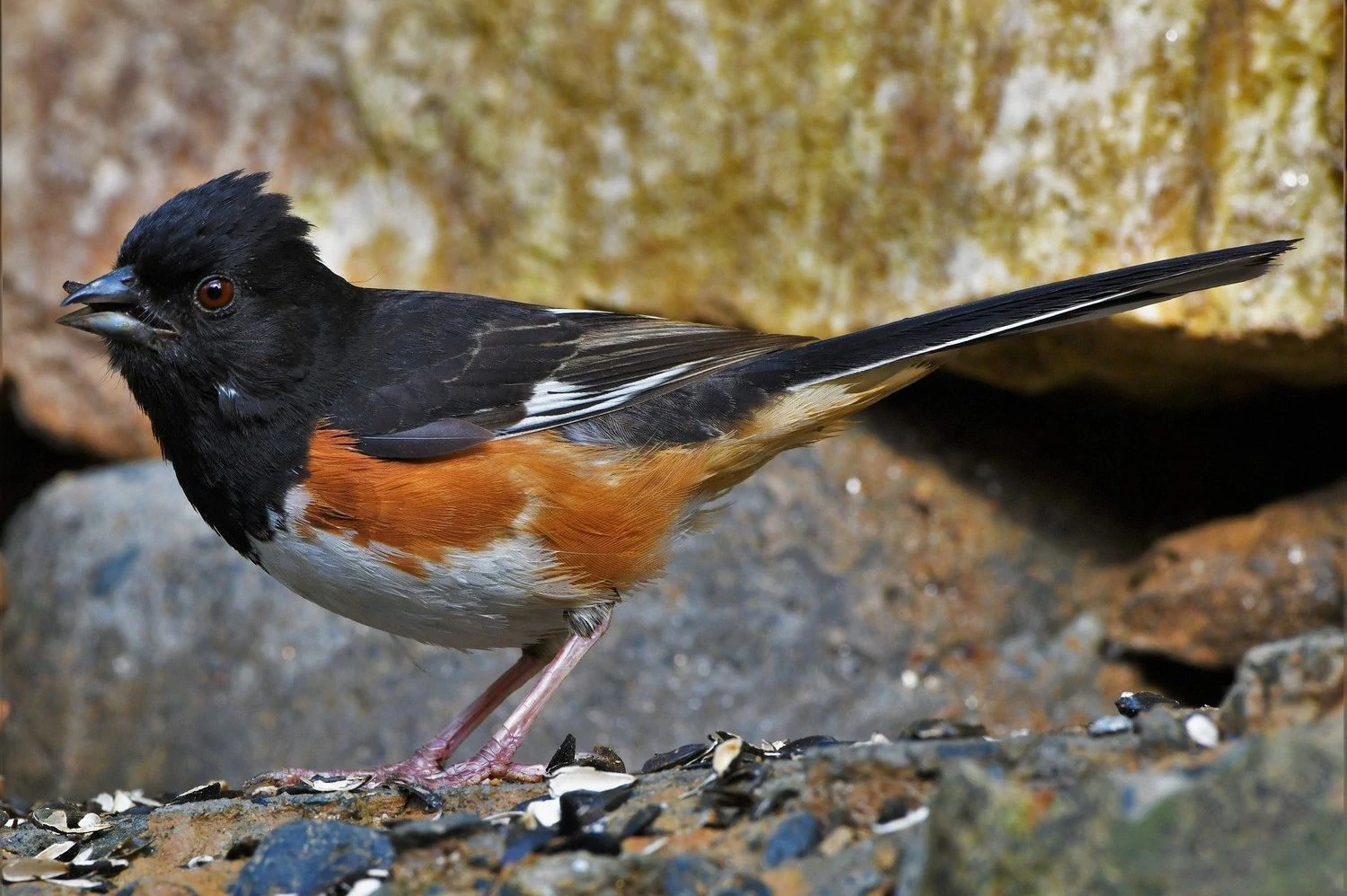
Eastern Towhees are winter birds in Texas and are mostly spotted from November to April in the east of the state.
Eastern Towhees are striking large sparrows, about the size of Robin, with a black head, throat, and back, reddish sides, long tails, and a white belly in the males. Females are similar but brown instead of black.
- Pipilo erythrophthalmus
- Length: 6.8-8.2 in (17.3-20.8 cm)
- Weight: 1.1-1.8 oz (32-52 g)
- Wingspan: 7.9-11.0 in (20-28 cm)
Eastern Towhees live all year in the southeastern US States, but birds further north move south for the winter.
You can find Eastern Towhees rummaging in the undergrowth and along the edges of forests and thickets.
Eastern Towhee sounds: Their song is a sharp note, followed by a trill.
Nests of Eastern Towhees are usually on the ground, hidden in fallen leaves. They are made from twigs, bark, and leaves, lined with soft grass and animal hair. They lay up to six eggs, which take just under two weeks to hatch and the same for young to fledge.
Attract Eastern Towhees to your backyard with overgrown borders and platform feeders with black oil sunflower seeds, hulled sunflower seeds, cracked corn, and millet.
Fun fact: Eastern Towhees love the sun and will be found on south-facing slopes.
LeConte’s Sparrow
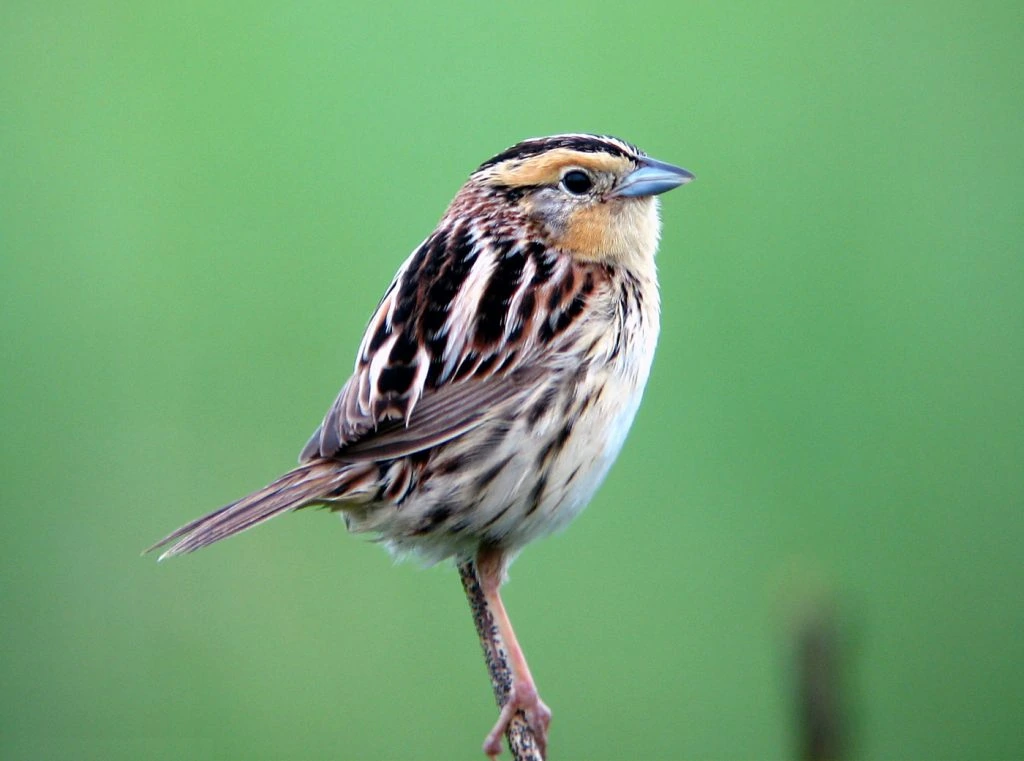
LeConte’s Sparrows can be seen in Texas during winter, from September to mid-May, mainly in the east of the state.
LeConte Sparrows are a dull orange with black streaks on their backs and wings. Their belly is white with pale orange across the chest. They also have gray patches on their cheeks and a dark eye line.
- Ammospiza leconteii
- Length: 4.7-5.1 in (12-13 cm)
- Weight: 0.4-0.6 oz (12-16.3 g)
- Wingspan: 6.3-7.1 in (16-18 cm)
LeConte’s Sparrows breed mainly in Canada and migrate to the south-central US states. They can be seen during migration over the Great Plains.
You can find Le’Conte’s Sparrows on the ground foraging for seeds and insects in dense grassland that is marshy or boggy. Unfortunately, they are so small and shy that they can be hard to spot.
LeConte’s Sparrow song:
Nests of LeConte’s Sparrows are near to the ground, hidden in dead grass and rushes and made from grass. They lay around five eggs which take about ten days to hatch.
Green-tailed Towhee
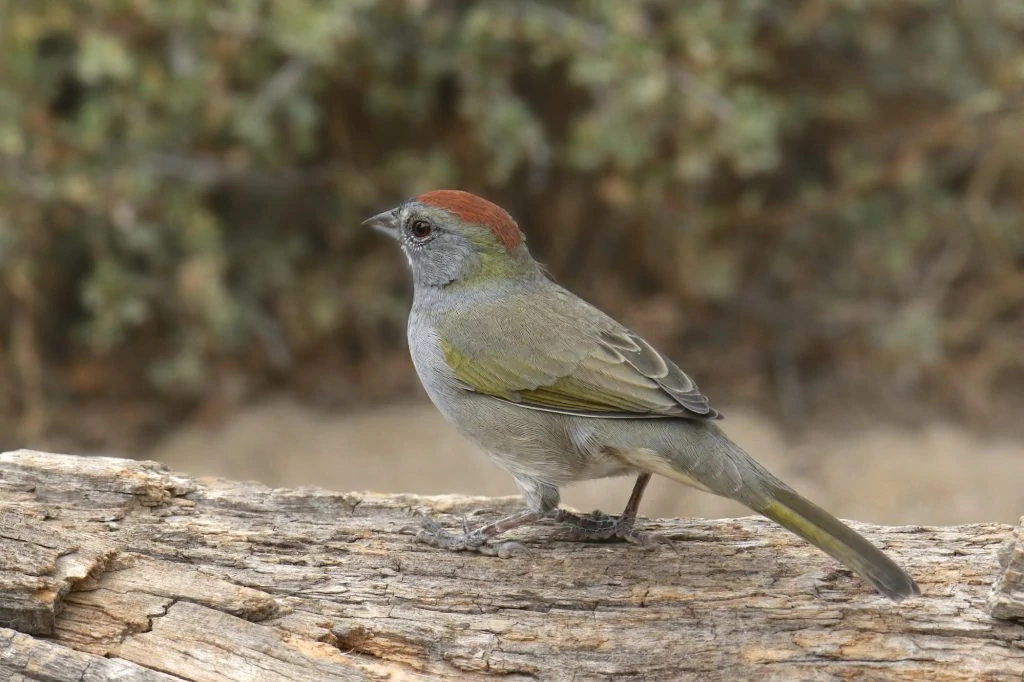
Green-tailed Towhees spend winter in southwestern Texas. However, they are also seen during the spring and fall migrations in the northwest of the state.
Green-tailed Towhees are large sparrows but small for towhees. They are gray with olive-green wings, backs, and tails, and they have a red crown.
- Pipilo chlorurus
- Length: 7.25 in (18.4 cm)
- Weight: 0.8-1.4 oz (21.5-39.4 g)
Green-tailed Towhees breed in western US states and migrate to southwestern US states and Mexico for winter. They are common in the mountainous west in summer.
You can find Green-tailed Towhees on the ground in dense shrubby vegetation in summer and desert grasslands and thickets, often near streams, in winter. They eat seeds, insects, and berries.
Green-tailed Towhee sounds: Their song is a pleasant series of whistles and slight buzzing.
Nests of Green-tailed Towhees are low in dense vegetation and are built by females from twigs, bark, and other plant material and lined with soft grass and animal hair.
They lay up to five eggs which take just under two weeks to hatch and around a further two weeks for the young to leave the nest.
Fun fact: Female Green-tailed Towhees distract potential predators by quietly leaving the nest and then running around with their tails raised near the nest predator.
Nelson’s Sparrow
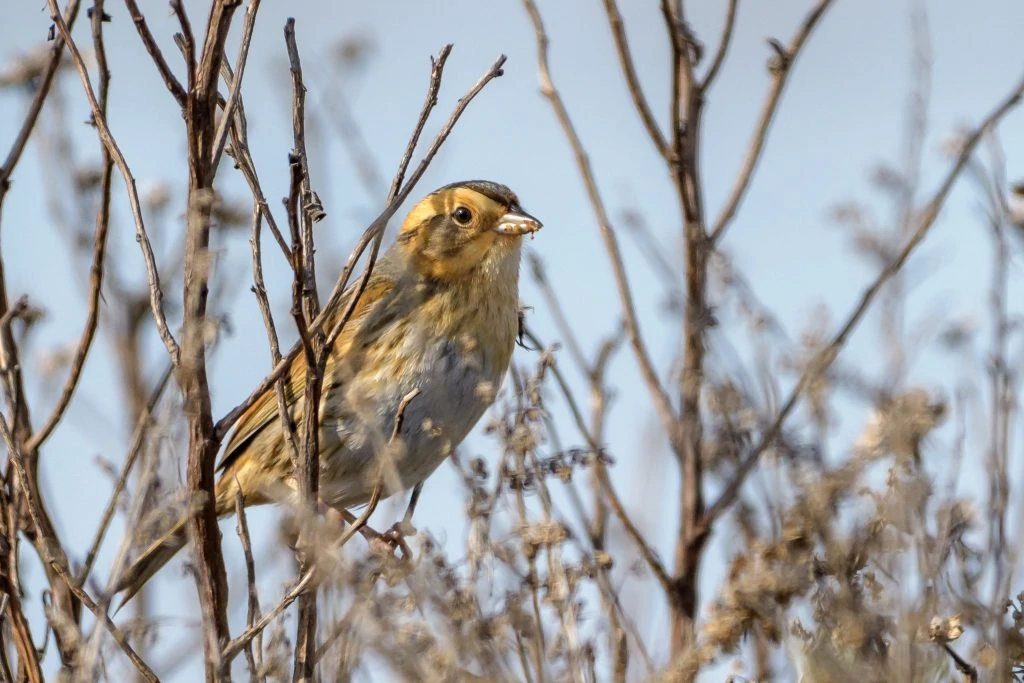
Nelson’s Sparrows are not often spotted in Texas, but they live mainly along the coast during winter, from September to May.
Nelson’s Sparrows are more orangy in color across the head and chest. Their backs are gray and brown-streaked, and their bellies are gray. Coastal birds are less bright in color than interior birds.
- Ammospiza nelsoni
- Length: 4.3-5.1 in (11-13 cm)
- Weight: 0.6-0.7 oz (17-21 g)
- Wingspan: 6.5-7.9 in (16.5-20 cm)
Nelson’s Sparrows breed mainly in central Canadian provinces, and then they migrate to the Gulf and Atlantic Coast for winter. They can be seen during migration across the Great Plains.
You can find Nelson’s Sparrows on the ground in wetlands in summer, foraging for seeds and insects. In winter, you can find them in saltwater and brackish marshes.
Nelson’s Sparrow sounds:
Nests of Nelson’s Sparrows are usually close to the ground and made from grass by the female. They lay up to six eggs which take under two weeks to hatch.
Fun fact: Nelson’s Sparrow males fly fast and far just above the marsh vegetation in a courtship display.
Sagebrush Sparrow
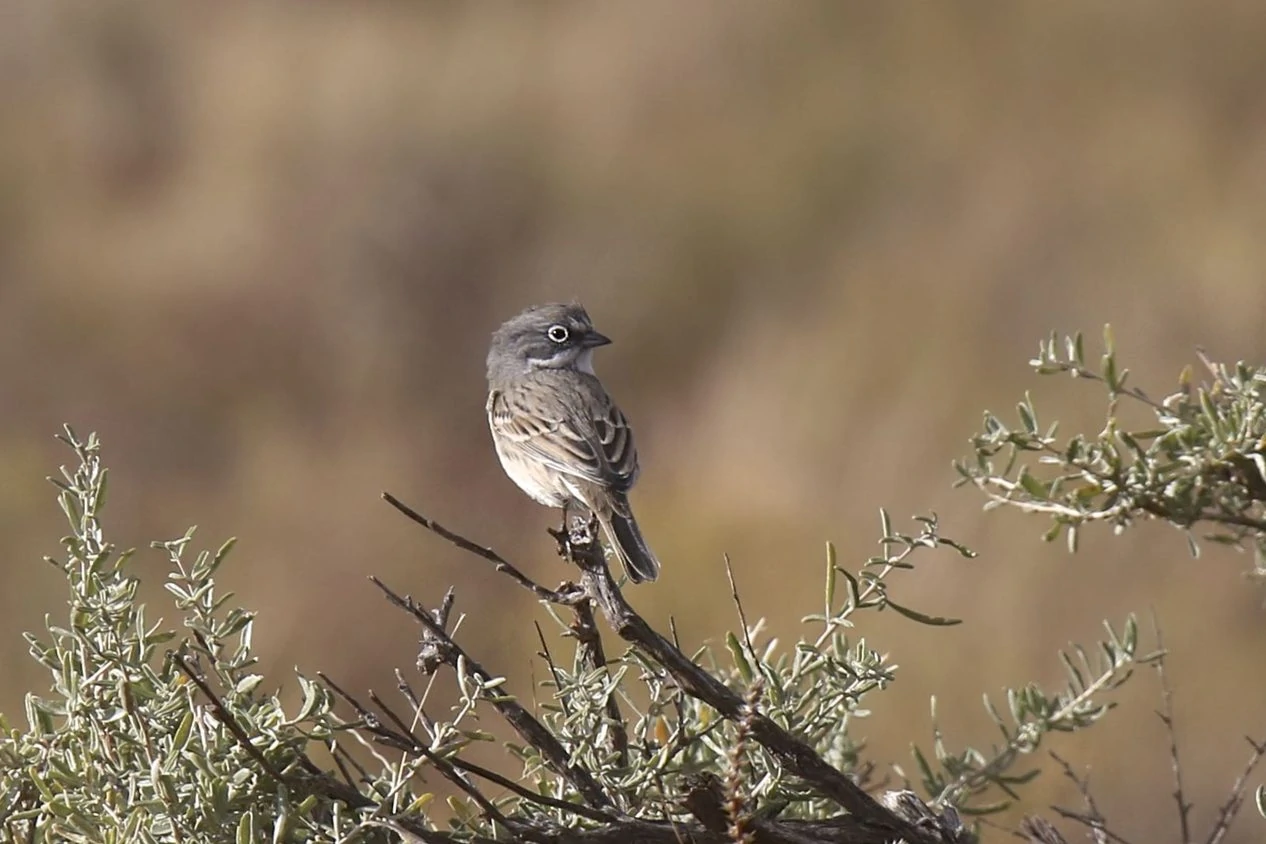
Sagebrush Sparrows are extremely rare to find in Texas, but there have been sightings here during winter, mainly in the west of the state.
Sagebrush Sparrows are medium-sized birds that are easier to recognize than other sparrows. Their head is gray with a white patch in front of their eyes. Their back has streaks of dark brown, and they have a dark-gray stripe on their throats. Their chests and bellies are white with a dark spot in the center.
- Artemisiospiza nevadensis
- Length: 16 cm (6.25 in)
- Weight: 20 g (0.7 oz)
- Wingspan: 21 cm. (8.25 in)
Sagebrush Sparrows are found inland in western US states. They breed in more northern areas and migrate south for winter. Some may remain all year in the middle of their range.
You can find Sagebrush Sparrows among undisturbed sagebrush and other shrubs. In winter, they migrate to brushy saltbush lands and other desert-like areas.
During the summer, Sagebrush Sparrows eat plenty of spiders and insects like ants, grasshoppers, and beetles. They also feed on seeds of grasses and weeds.
Sagebrush Sparrows song:
Nests of Sagebrush Sparrows are found within sagebrush or saltbush. They are built low to the ground and made out of twigs and sticks and lined with grass and weeds. Females lay three to four eggs that hatch within sixteen days. The young leave their nest around eleven days after hatching.
Fun Fact: Sagebrush Sparrows will return to their successful “tried and tested” breeding sites every year.
Henslow’s Sparrow
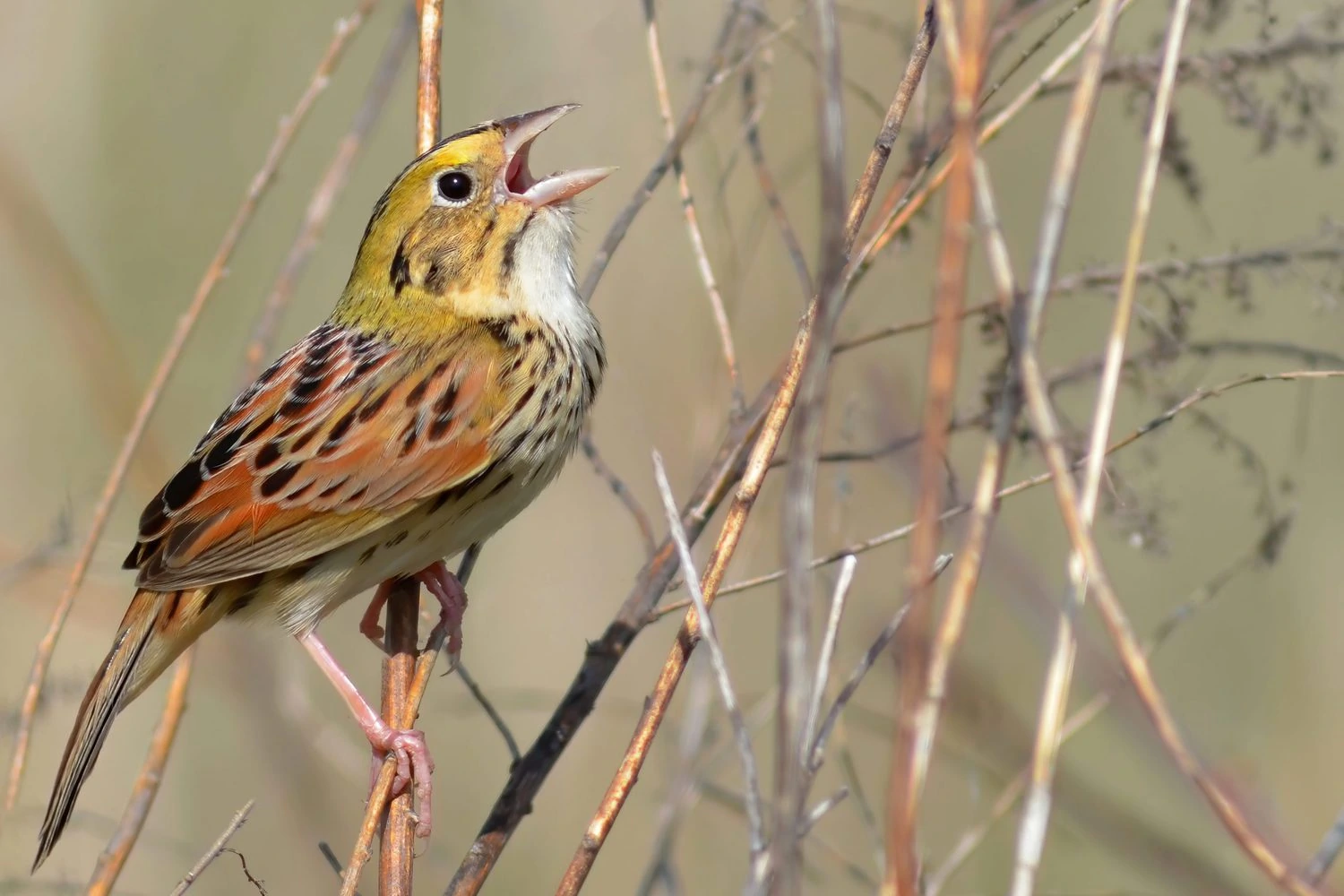
Henslow’s Sparrows are very rare to spot in Texas, but they have been seen here during winter, from October to May.
Henslow’s Sparrows’ physical characteristics are perfect for hiding in their native environment. They have greenish faces with distinctive black stripes, pale chests, and their bellies are white with a bit of streaking, and they have a reddish back.
It’s hard to tell the difference between males and females, and even juveniles look similar but with a paler color combination and fewer streaks on their bellies.
- Centronyx henslowi
- Length: 12 – 13 cm (4.75 – 5.25 in)
- Weight: 14 g (0.5 oz)
- Wingspan: 18 – 19 cm (7 – 7.5 in)
Henslow’s Sparrows breed in northeastern US states and then migrate to southeastern US states for winter.
You can find Henslow’s Sparrows in wet, weedy, and dense grasslands. However, their natural habitat is slowly disappearing, and they are now making their way towards abandoned farm fields, pastures, and anywhere they can find dense, tall grasslands.
Henslow’s Sparrows are highly secretive birds preferring to stay low and forage at the bottom of grass stalks. They eat seeds like sedges, ragweed, and smartweed. They also eat insects in the summer, such as grasshoppers and caterpillars. They’ve been known to eat berries, too.
Henslow’s Sparrow call/song:
Nests of Henslow’s Sparrows are made from grass and wildflowers placed in slight hollows or at the base of dense clumps of grass. The female lays three to five eggs, which she incubates for eleven days. It takes ten days for the young to fledge, and they are still cared for by their parents for a short period even after they leave the nest.
Fun Fact: Henslow’s Sparrows prefer to run through dense grass rather than fly from danger.
American Tree Sparrow
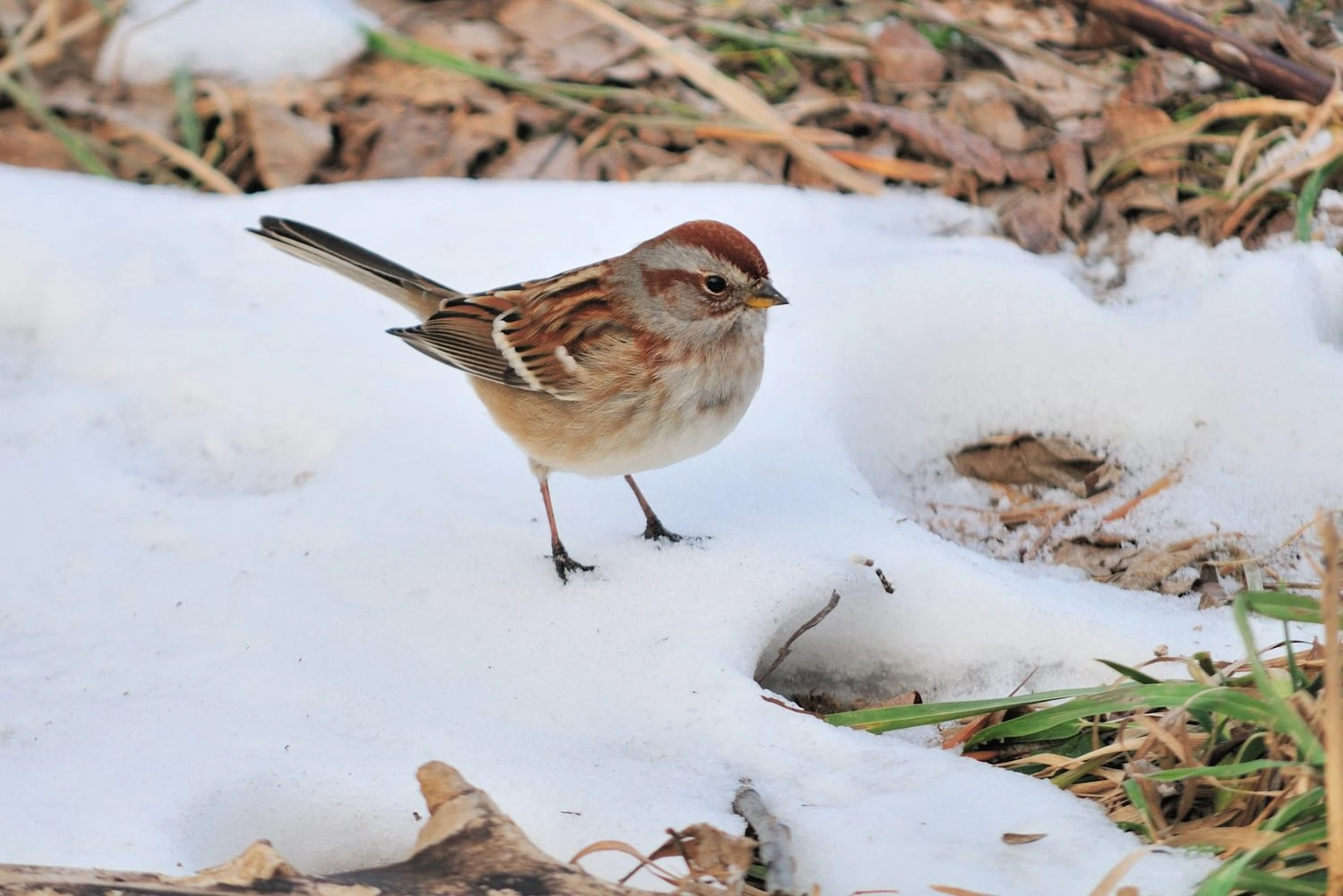
American Tree Sparrows are extremely rare to find in Texas, but there have been sightings here during winter, mostly in the north of the state.
American Tree sparrows are long-tailed brown-streaked plump birds with rusty caps, gray faces, and a rusty eye line.
- Spizelloides arborea
- Length: 5.5 in (14 cm)
- Weight: 0.5-1.0 oz (13-28 g)
- Wingspan: 9.4 in (24 cm)
American Tree Sparrows are a bird of winter in the US and a bird of summer in Canada.
They breed in the far north of Canada and in Alaska and migrate to most US states for the winter, except the Pacific and Gulf Coasts.
You can find American Tree Sparrows foraging in small flocks in weedy fields and under bird feeders.
American Tree Sparrows sounds: Males sing a pleasant song from late winter, before migration. Their song is a tuneful series of rising and falling whistles.
Nests of American Tree Sparrows’ are usually on or near to the ground and are made of twigs, grass, and moss. They lay around five eggs, and these take just under two weeks to hatch and just over a week for the young to fledge.
Attract American Tree Sparrows to your backyard platform feeders with black oil sunflower seeds, nyjer, cracked corn, and millet. They also feed seeds dropped on the ground from tube feeders.
Fun fact: American Tree Sparrows do not spend much time in trees but forage and nest on the ground. Their name comes from European settlers that thought they looked similar to the European Tree Sparrow.
Baird’s Sparrow
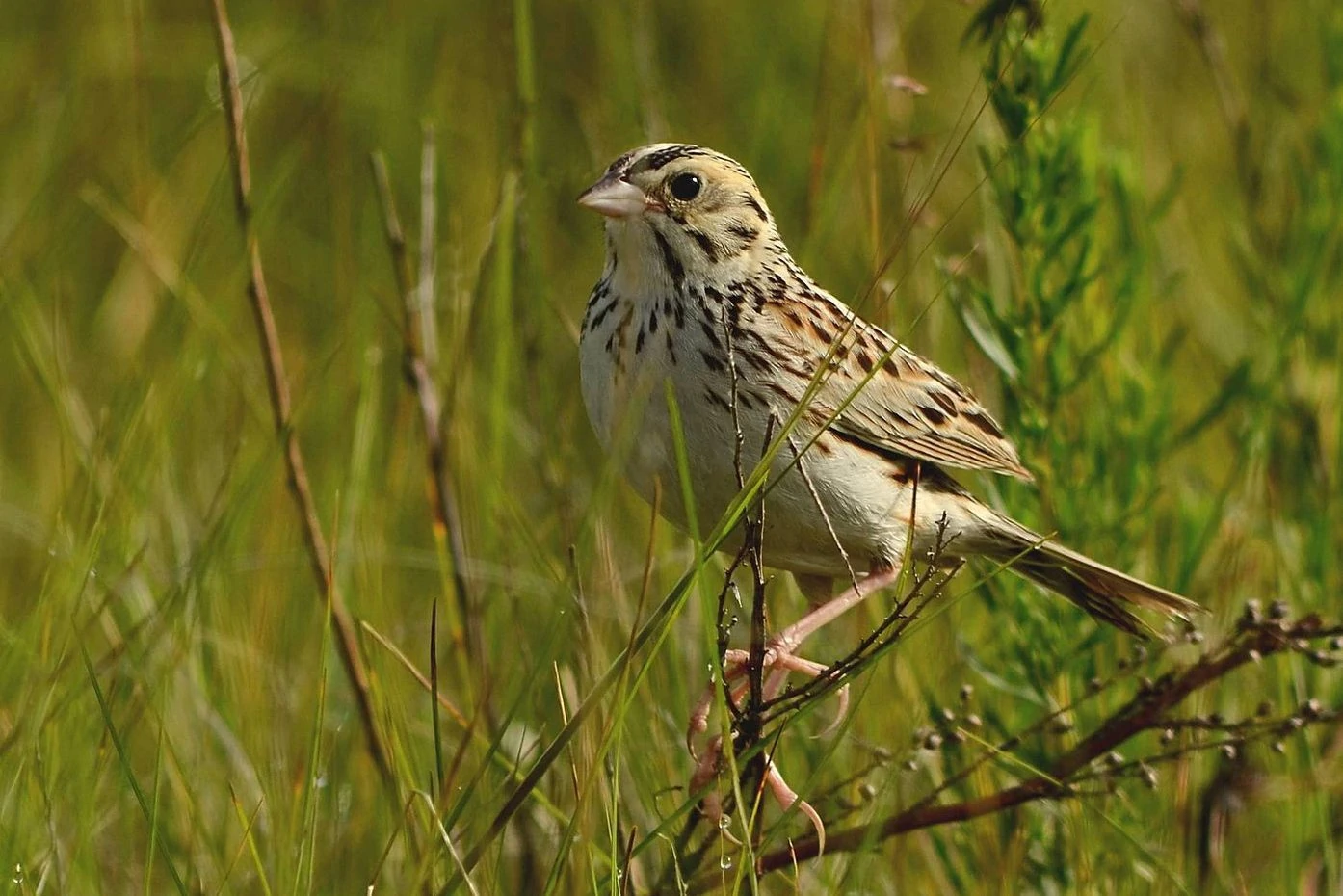
Baird’s Sparrows are extremely rare to find in Texas, but they have been spotted here during winter, mostly in the west of the state.
Baird’s Sparrows are medium-sized yellowish-brown birds. They are recognizable because of the narrow, brown streaks on their throats, very much like a necklace on their bodies.
Their heads also have a central dark brown stripe, and their backs have light and dark brown stripes. Their bellies are yellowish or white. Males and females look the same, but juveniles are paler in color.
- Centronyx bairdii
- Length: 14 cm (5.5 in)
- Weight: 23 g (0.8 oz)
- Wingspan: 22 cm (8.5 in)
Baird’s Sparrows breed in the northern Great Plains and migrate south for winter to northern Mexico and the southwestern United States.
You can find Baird’s Sparrows in tall grass prairies or mixed grass prairies. Due to their diminishing habitats, they can now be found in ungrazed pastures, grasslands, and agricultural fields.
Baird’s Sparrows stay low and hidden on the ground when foraging for food. They usually walk or hop between clumps of grass to collect seeds and insects.
Baird’s Sparrow song:
Nests of Baird’s Sparrows are usually built in shallow holes on the ground or hidden within clumps of grass. They are made of grass and weeds with soft materials lining the inside. There may be two to six eggs in a nest. The female incubates them for about twelve days.
Fun Fact: Baird’s Sparrows continually shift their breeding regions from year to year in reaction to environmental hazards and roving bison herds.
Sparrows in Texas during Migration
Clay-colored Sparrow
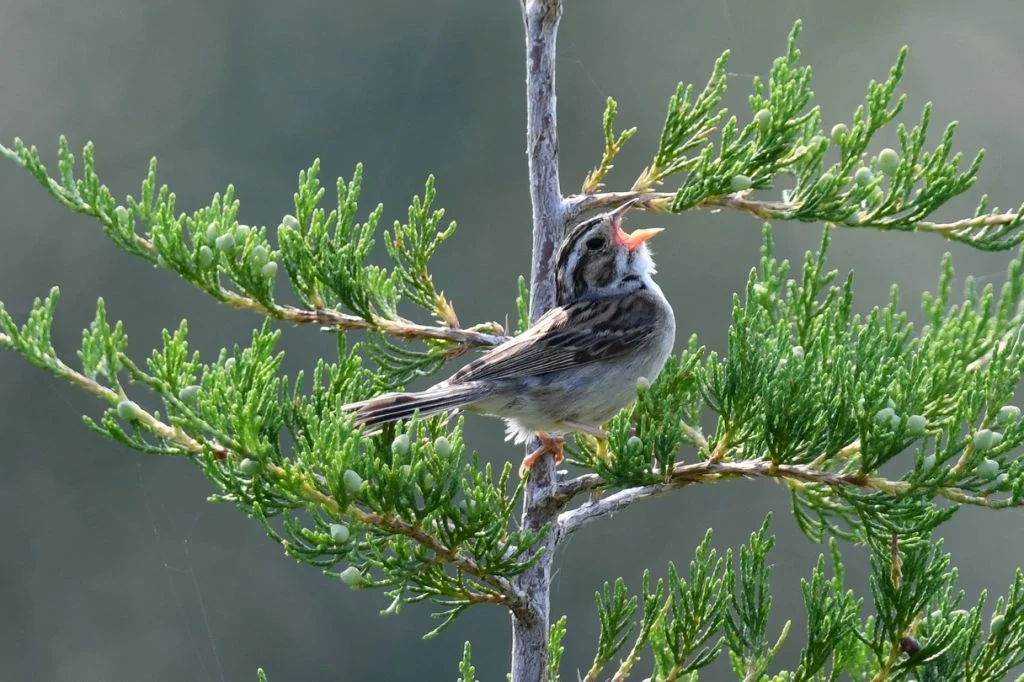
Clay-colored Sparrows can be found in Texas during the spring and fall migrations from March to May and September to October, but some also stay for winter in the south of the state. They appear in nearly 5% of checklists during migrations.
These small, plain birds of the northern prairies and Great Plains have distinctive head markings which set them apart from other sparrows. They have a gray collar around their necks and long notched tails.
- Spizella pallida
- Length: 5.1 – 6 in (13 – 15 cm)
- Weight: 0.42 oz (12 g)
- Wingspan: 7.5 in (19 cm)
Clay-colored Sparrows are the most common sparrow you can spot in summer in the northern prairies. They breed in Canada and the northern Great Plains before migrating south to Texas and Mexico.
In summer, you can find Clay-colored Sparrows in shrubland, looking for seeds, leaf buds, or the occasional insect.
Clay-colored Sparrow sounds: Their song is a two-note buzzing sound.
Nests of Clay-colored Sparrows are usually close to the ground and well hidden in vegetation. The female makes them from twigs and grass, and they are lined with softer grasses and animal hair.
They lay up to five eggs which take around two weeks to hatch and a further week for the young to leave the nest.
Fun fact: Young Clay-colored Sparrows leave the nest before they can fly, and they have to run for cover when there is danger.
Brewer’s Sparrow
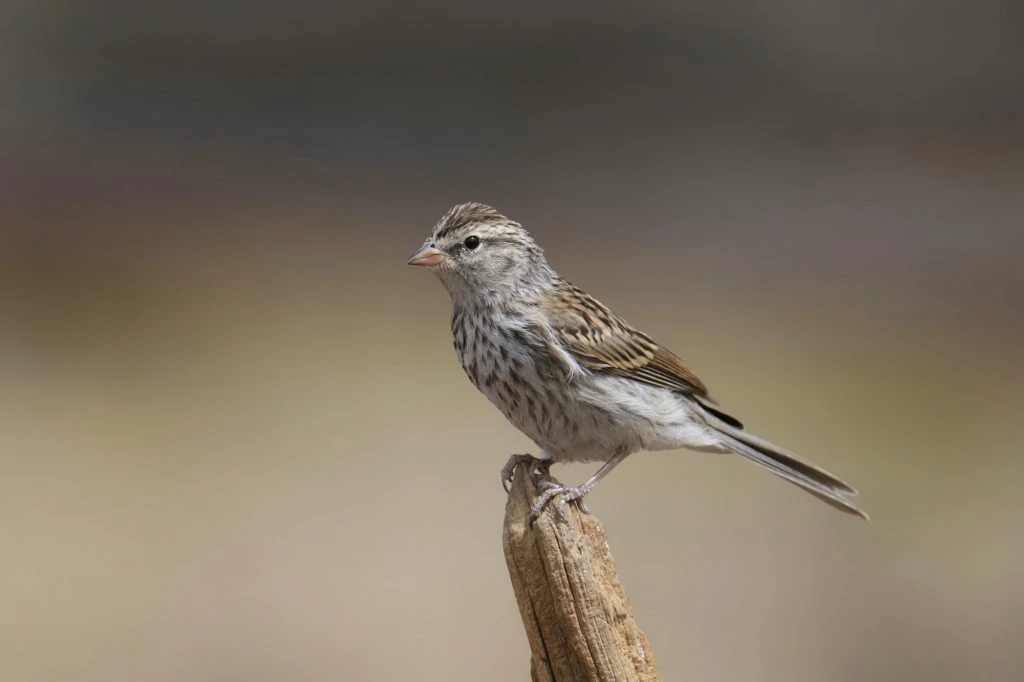
Brewer’s Sparrows are mainly seen in western Texas during the spring and fall migrations in April to May and September to October. However, some remain during winter in the southwest of the state.
Brewer’s Sparrows are gray underneath and streaked brown on their backs. They have long tails with a notch at the end and small bills. Brewer’s Sparrows are the smallest sparrow in North America.
- Spizella breweri
- Length: 5.1-5.9 in (13-15 cm)
- Weight: 0.4-0.5 oz (11-14 g)
- Wingspan: 7.1-7.9 in (18-20 cm)
Brewer’s Sparrows breed in western US states and western Canada and migrate south for winter to southwestern US states and Mexico. They are very common sparrows in their range.
You can find Brewer’s Sparrows in arid sagebrush foraging for insects, such as caterpillars, grasshoppers, and spiders. In winter, they will also eat seeds.
Brewer’s Sparrow sounds: Their song is a buzzing sound that often descends and slows down.
Nests of Brewer’s Sparrows are built by females in shrubs from dry grass. They lay up to five eggs which take around eleven days to hatch and around a further eight days for the young to leave the nest.
Fun fact: Brewer’s Sparrows are small but mighty, and they will mob and chase predators away from their nests.
Other Sparrows in Texas
Seaside Sparrow
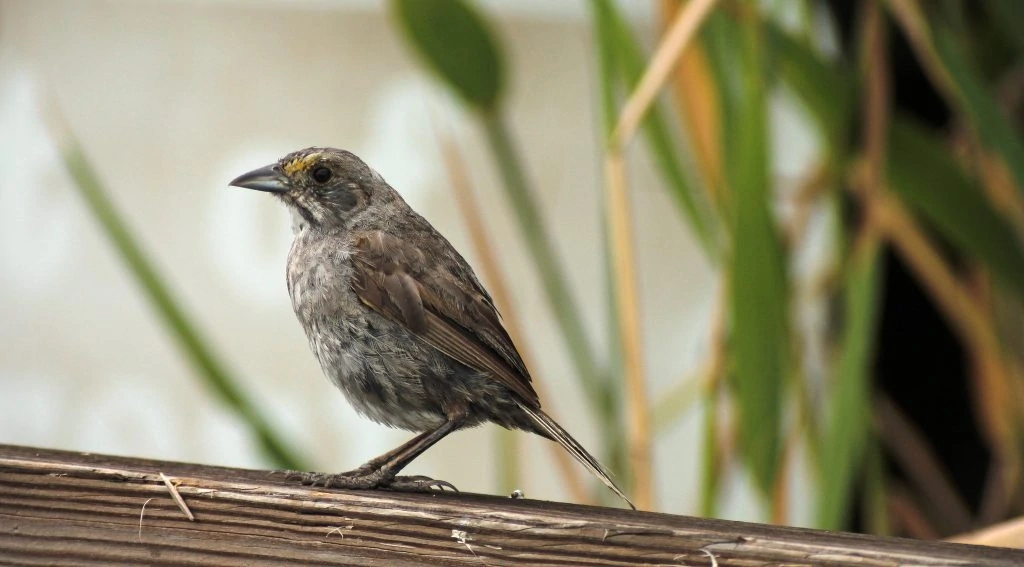
Seaside Sparrows can are only spotted along the coast of Texas.
Seaside Sparrows are grayer than most sparrows, and they have a yellow spot in front of their eye. They are chunky birds with long bills.
- Ammospiza maritimus
- Length: 5.1-5.9 in (13-15 cm)
- Weight: 0.7-1.0 oz (19-29 g)
- Wingspan: 7.1-7.9 in (18-20 cm)
As you can guess, Seaside Sparrows are found along the coast in salt marshes. They live along the Gulf and Atlantic coasts of the US, and those that breed in the north of their range migrate south, but the rest remain all year.
You can find Seaside Sparrows in marshes foraging for seeds, insects, and spiders. They also use their large bill for digging in the mud for tiny sea creatures.
Seaside Sparrow Call/Song: A few notes followed by a buzz.
Nests of Seaside Sparrows are built by females in tall marsh vegetation from tightly woven grass. They also often build a cover from surrounding vegetation. They lay up to five eggs which take around two weeks to hatch and a further ten days for the young to leave the nest.
Fun fact: Young Seaside Sparrows cannot fly when they leave the nest, and they take a further week before they are confident flyers.
Black-chinned Sparrow
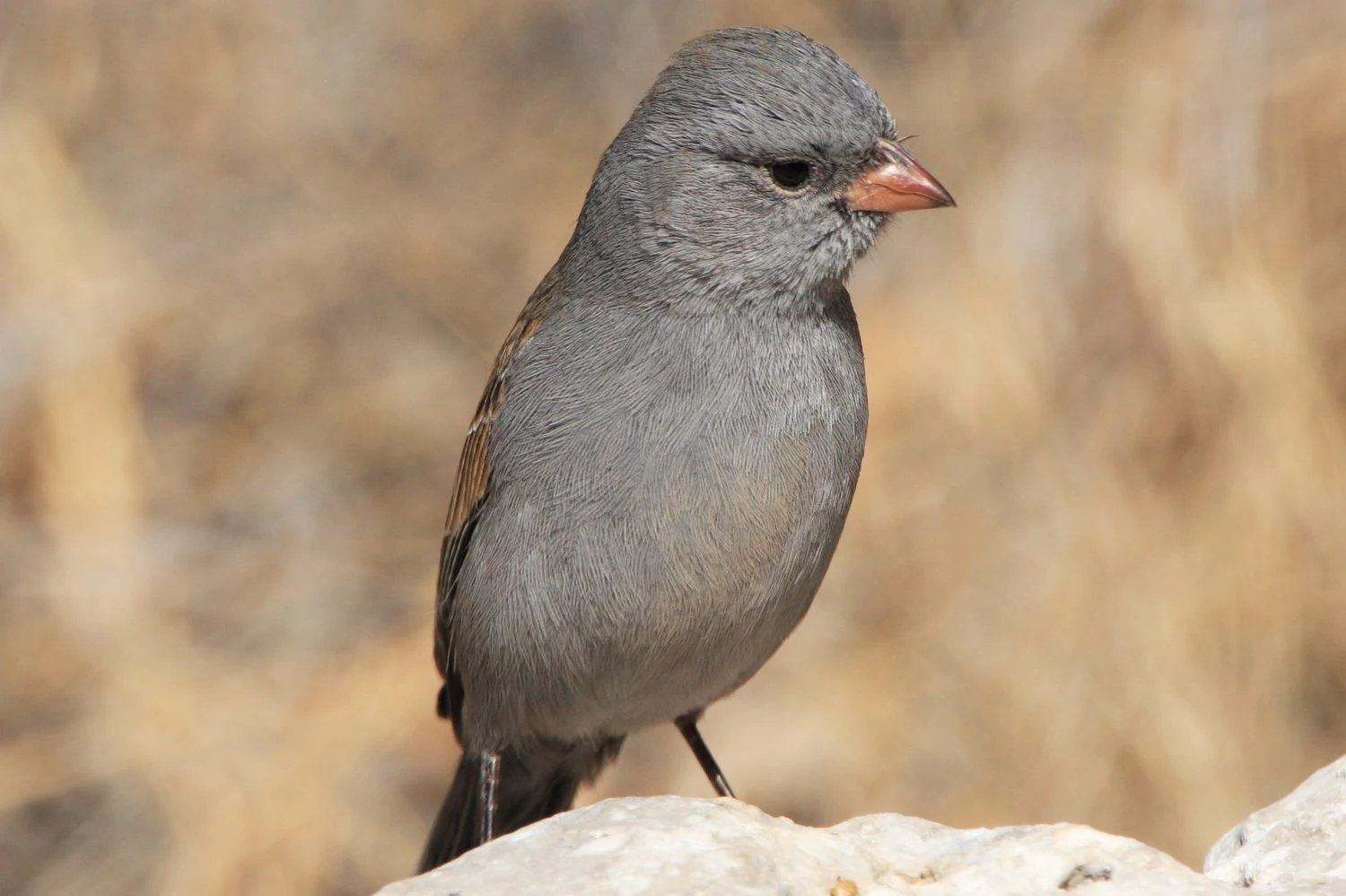
Black-chinned Sparrows are spotted in western Texas but rarely.
Black-chinned Sparrows are plain and mainly gray overall but with brown backs and wings. Males have the black patch on their throat, but the females and non-breeding males don’t. Their bills are pink, which contrasts with their gray heads, and makes them easier to spot.
- Spizella atrogularis
- Length: 15 cm (5.75 in)
- Weight: 11 g (0.4 oz)
- Wingspan: 23 cm (9 in)
Black-chinned Sparrows breed in southwestern US states and migrate south to Mexico for winter.
You can find Black-chinned Sparrows in arid, desert-like environments. They prefer to live in remote and rocky areas with sagebrush, pine-juniper vegetation, and other brushes and scrubs. They may move south of their breeding locations in winter, usually to lower elevations.
Black-chinned Sparrows spend much of their time foraging for seeds on the ground and under shrubs. They feed on insects during the summer and more grains and seeds during the winter. They may capture insects while flying.
Black-chinned Sparrow song:
Nests of Black-chinned Sparrows are found near the ground and built within a dense shrub. They are made of grass, weeds, rootlets, and yucca fibers and made soft with hair and feathers. There may be as many as five eggs per nest, and they take about a week to hatch. It takes as long as fifteen days for them to learn how to fly, and in the meantime, their parents continue to care for them until they do.
Fun Fact: Black-chinned Sparrows are on the list of protected species by the Migratory Bird Treaty Act. Their habitat is endangered, and their nests are highly-susceptible to predation.
How to Attract Sparrows to Your Backyard
Sparrows are easy to attract to your yard with these easy to follow tips.
- Provide their favourite seeds which include sunflower seeds nyjer, millet and cracked corn.
- Plant native plants and shrubs to attract insects
- Provide a water feature with clean running water
- Don’t put feeders near sheltered areas where cats may pounce.
Most Commonly Spotted Sparrows in Texas:
Bird watchers submit checklists on ebird, and this shows how frequently all the sparrows in Texas are spotted:
- House Sparrow 23.1%
- Savannah Sparrow 8.8%
- Chipping Sparrow 8.3%
- Lincoln’s Sparrow 7.7%
- White-crowned Sparrow 6.3%
- White-throated Sparrow 6.1%
- Lark Sparrow 5.2%
- Dark-eyed Junco 4.9%
- Song Sparrow 4.1%
- Field Sparrow 3.6%
- Spotted Towhee 2.8%
- Olive Sparrow 2.7%
- Vesper Sparrow 2.7%
- Swamp Sparrow 2.3%
- Black-throated Sparrow 1.7%
- Rufous-crowned Sparrow 1.7%
- Harris’s Sparrow 1.6%
- Canyon Towhee 1.5%
- Clay-colored Sparrow 1.3%
- Grasshopper Sparrow 0.9%
- Cassin’s Sparrow 0.8%
- Fox Sparrow 0.8%
- Lark Bunting 0.6%
- Eastern Towhee 0.5%
- Seaside Sparrow 0.4%
- LeConte’s Sparrow 0.3%
- Green-tailed Towhee 0.3%
- Brewer’s Sparrow 0.3%
- Black-chinned Sparrow 0.1%
- Nelson’s Sparrow 0.1%
- Botteri’s Sparrow <0.1%
- Bachman’s Sparrow <0.1%
- Sagebrush Sparrow <0.1%
- Henslow’s Sparrow <0.1%
- American Tree Sparrow <0.1%
- Baird’s Sparrow <0.1%

